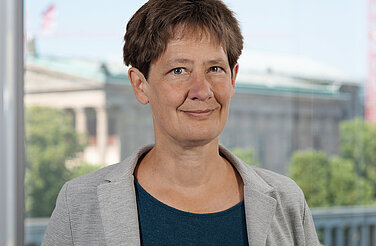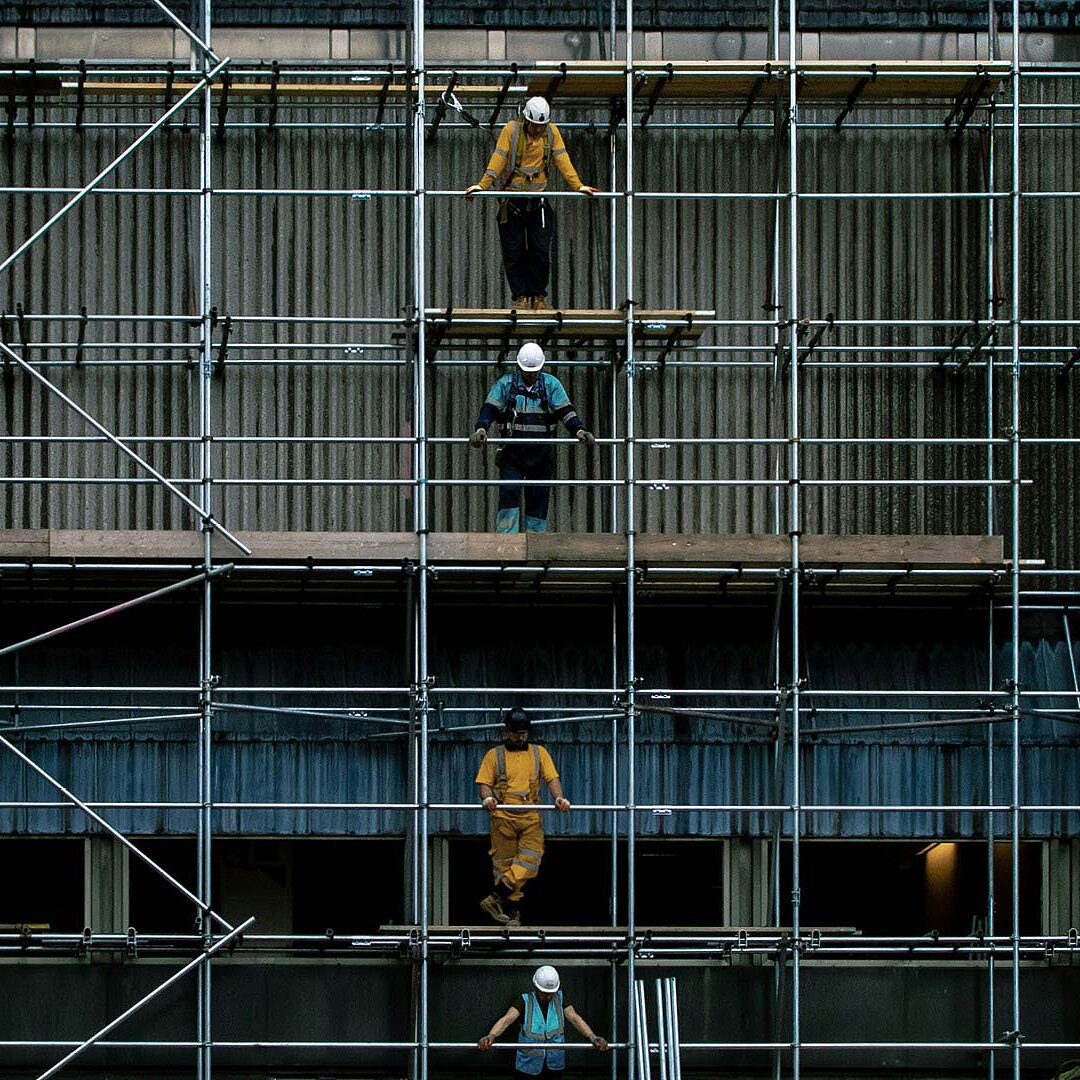-
The path to a climate-neutral Germany requires planning and investment certainty.
Climate policy works – emissions in the energy sector have fallen by around 40 percent since 2014. However, the transition in the transport sector, the climate-neutral modernisation of buildings and the necessary changes in the industry sector still pose challenges. To overcome these challenges, reliable climate and economic policy frameworks are crucial.
-
Investments in climate neutrality boost innovation and improve structural competitiveness.
Three quarters of the investments in energy and transport infrastructure, industrial facilities and buildings required by 2045 are necessary regardless of the transition. Redirecting financial flows towards climate-neutral solutions through price incentives and market regulation is therefore crucial. Additional investments in climate action amount to an average of three percent of GDP. Many of these investments are already economically viable; for example, renewable energy projects and electricity grids can be 90 percent financed by market revenues and fees.
-
Achieving climate-neutral and equitable housing and mobility requires extensive infrastructure expansion, targeted investment support and measures to correct social imbalances.
The scenario includes more targeted support for building retrofits, purchase incentives for electric vehicles that focus on small and used cars and the expansion of public transport infrastructure. These measures will help to bring down energy costs in the medium term. Until they take effect, vulnerable households will be compensated for cost increases by a temporary support mechanism, fed by ten billion euros per year from carbon pricing revenues.
-
A balanced policy mix ensures successful implementation.
Relying solely on carbon pricing, market regulation, subsidies or infrastructure expansion has its disadvantages. By contrast, a combined approach allows for cost efficiency, planning certainty and social equity. Regardless of the exact composition of the policy mix, the path to climate neutrality requires a collective societal effort – and paves the way for a liveable future for everyone.
This content is also available in: German
- Format
- Study
- Date
- 10 April 2025
Climate-neutral Germany
From target-setting to implementation
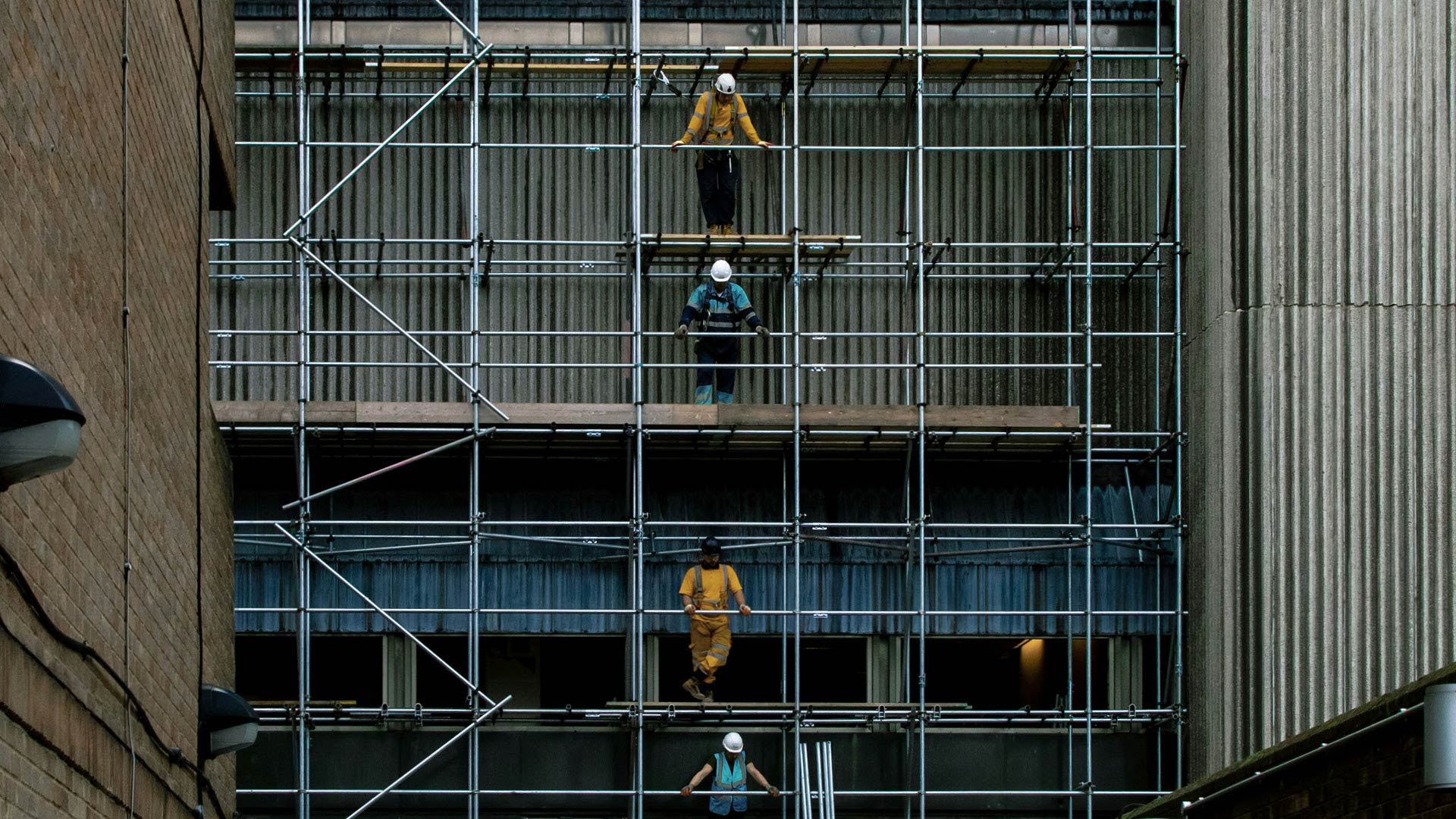
Preface
Germany has set out on the path to climate neutrality. Despite significant progress, such as the expansion of renewable energy, the current debate remains focused primarily on the challenges. It’s true that the transition in transport and mobility and the climate-neutral modernisation of buildings are bringing about changes in citizens’ daily lives. Meanwhile, a growing segment of the economy is facing significant structural challenges.
In updating our “climate-neutral Germany” scenario, we take these challenges into account and provide possible solutions. Our analysis demonstrates how a bold strategy can set the course for climate-neutral investments. It identifies key elements for socially equitable design and formulates a balanced policy mix to achieve this goal.
This pathway will certainly not unfold exactly the way we describe. However, the study presents a cohesive vision of the future and can thus form the basis for the solution-oriented discussions we need.
Key findings
Bibliographical data
- Authors
- Lea Nesselhauf, Corinna Fischer, Simon Müller, Philipp Godron, Fabian Huneke, Mathias Koch, Niels Wauer, Uta Weiß (all Agora Energiewende); Julia Metz, Paul Münnich (both Agora Industry); Arnaud Brizay, Christine Chemnitz, Wilhelm Klümper (all Agora Agriculture); Carl-Friedrich Elmer, Marion Vieweg, Johanna Wietschel (all Agora Verkehrswende)
- Publication number
- 362/01-S-2025/EN
- Version number
- 1.0
- Publication date
-
10 April 2025
- Pages
- 83
- Suggested Citation
- Agora Think Tanks (2024): Climate-neutral Germany. From target-setting to implementation.
- Project
- This publication was produced within the framework of the project Climate-neutral Germany.
Downloads
-
Study
pdf 6 MB
Climate-neutral Germany
From target-setting to implementation
All figures in this publication
Measures in the climate-neutral Germany 2024 scenario
Figure 1 from Climate-neutral Germany on page 9
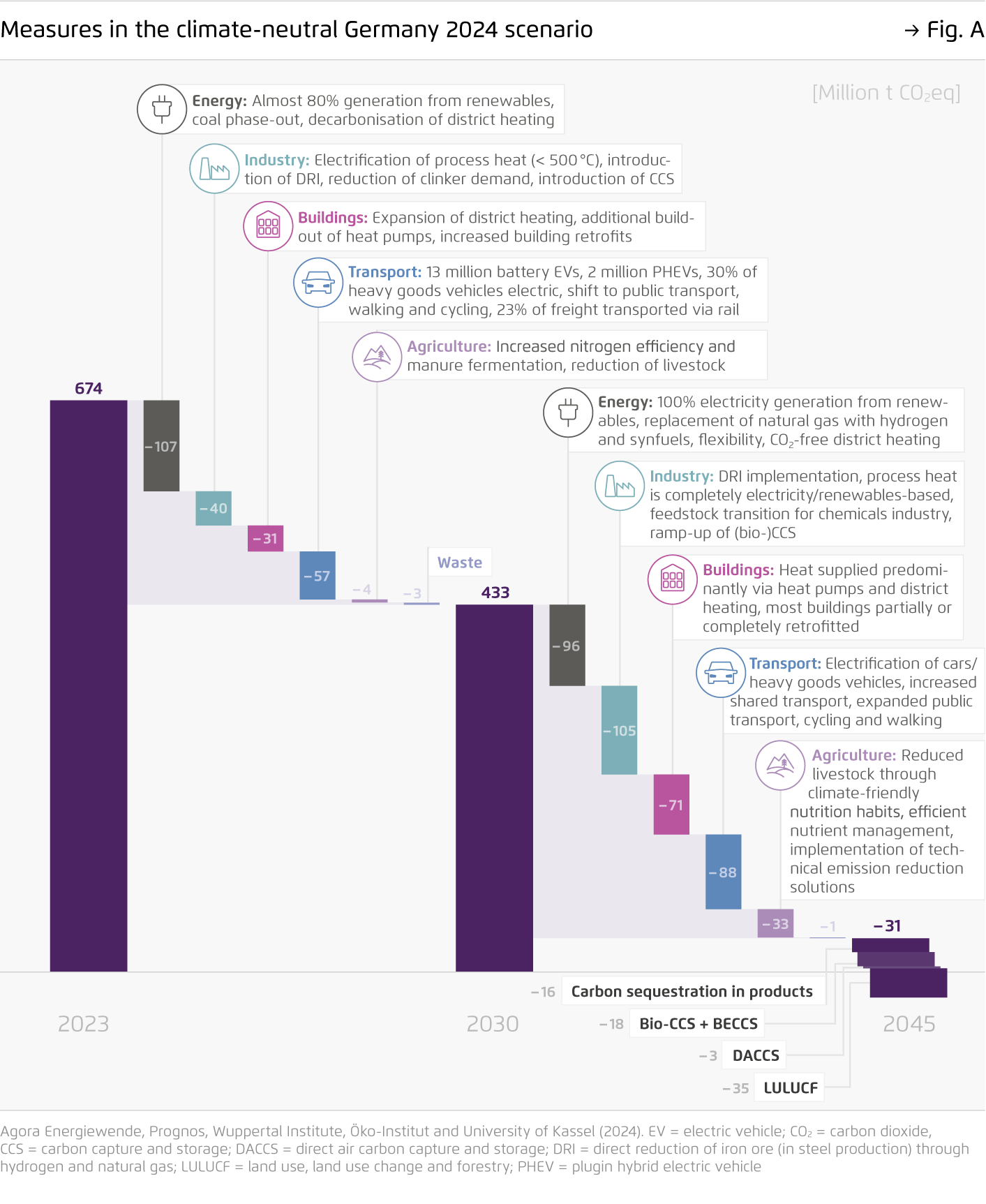
Under consideration of the Creative Commons license CC BY (attribution) the image may be further processed in any format or medium (also commercially, also in modified form), as long as the author is mentioned and a link to the license is given.
Greenhouse gas emission reduction pathways by sector, until 2045
Figure 2 from Climate-neutral Germany on page 10
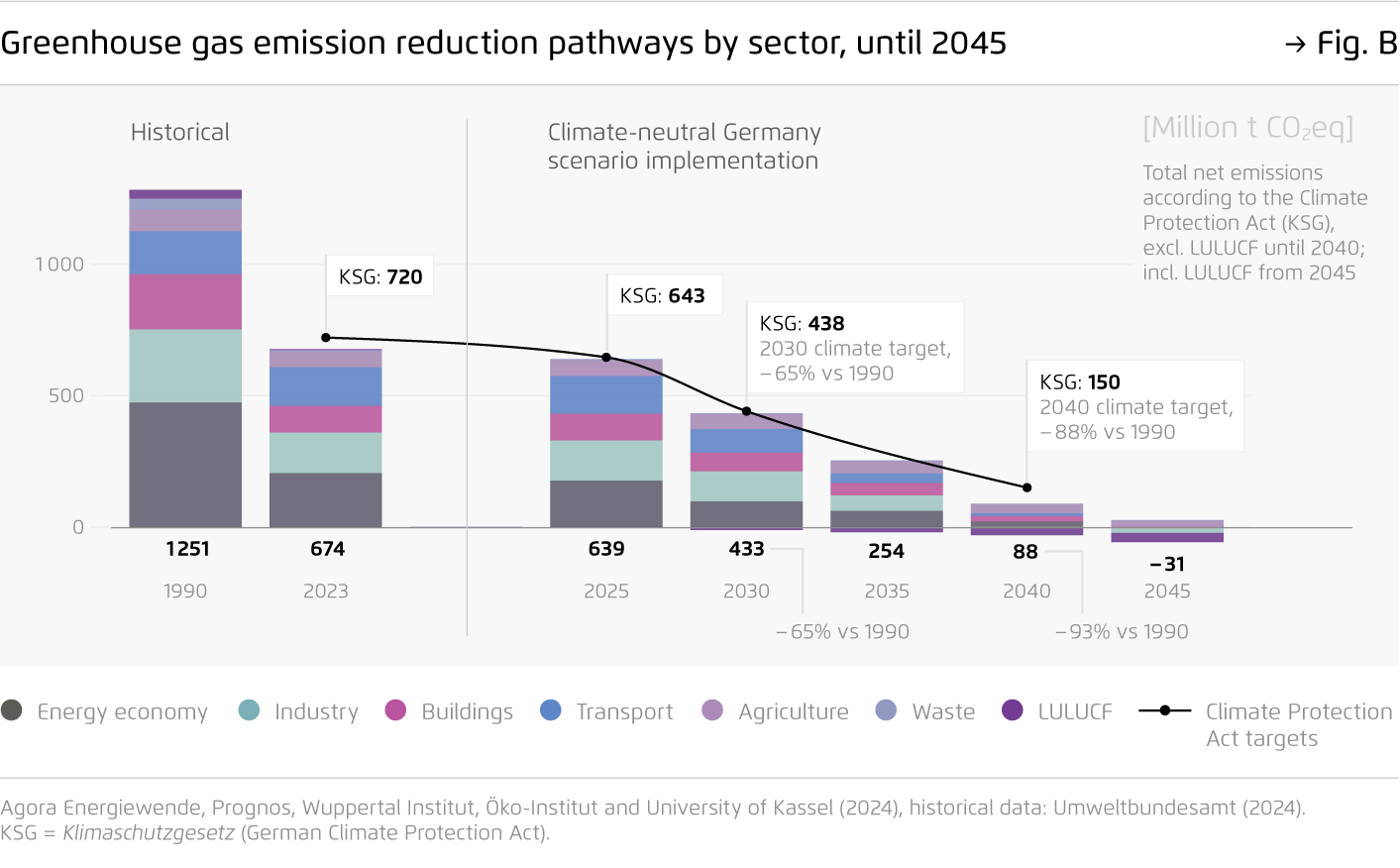
Under consideration of the Creative Commons license CC BY (attribution) the image may be further processed in any format or medium (also commercially, also in modified form), as long as the author is mentioned and a link to the license is given.
The average annual investment volume is 11.2 percent of the gross domestic product (GDP)
Figure 3 from Climate-neutral Germany on page 11
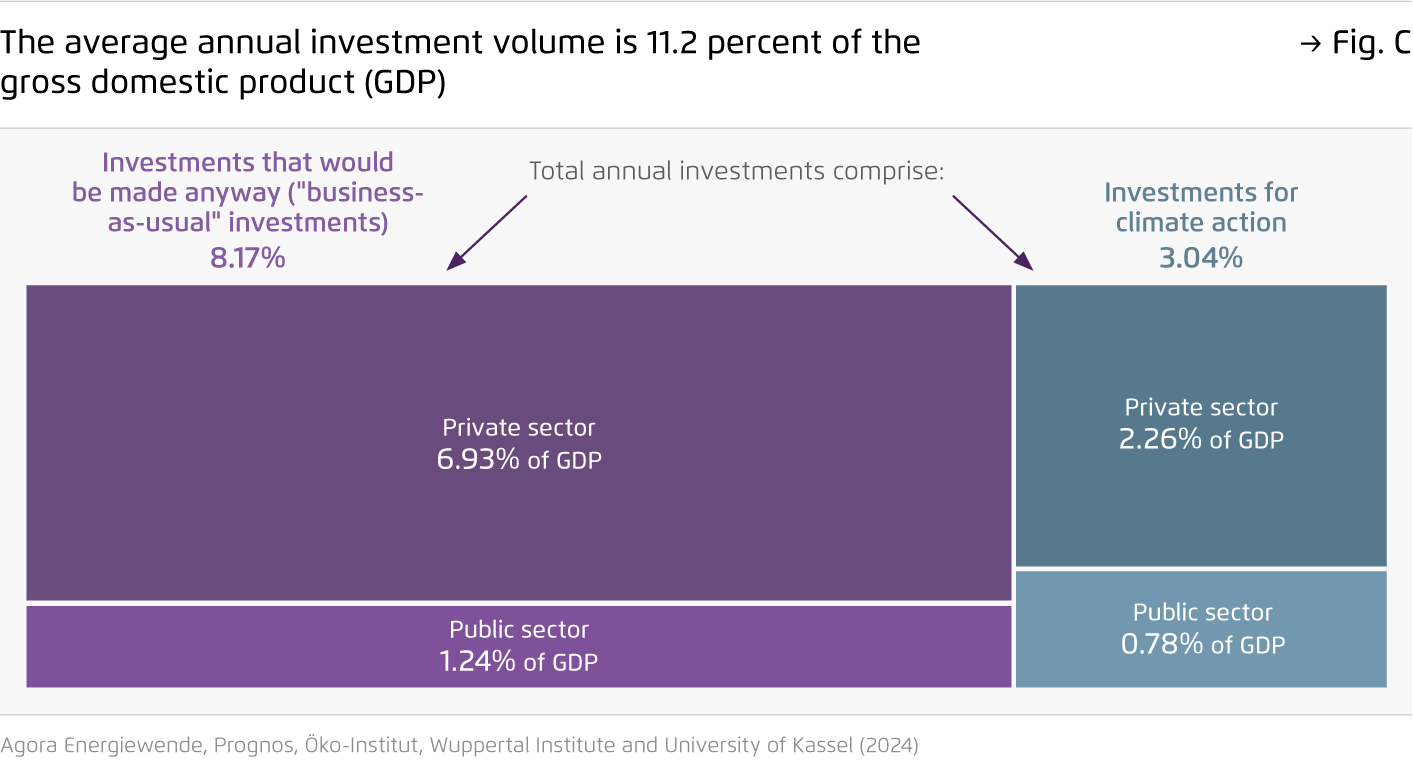
Under consideration of the Creative Commons license CC BY (attribution) the image may be further processed in any format or medium (also commercially, also in modified form), as long as the author is mentioned and a link to the license is given.
A balanced policy mix is the key to climate neutrality
Figure 4 from Climate-neutral Germany on page 12
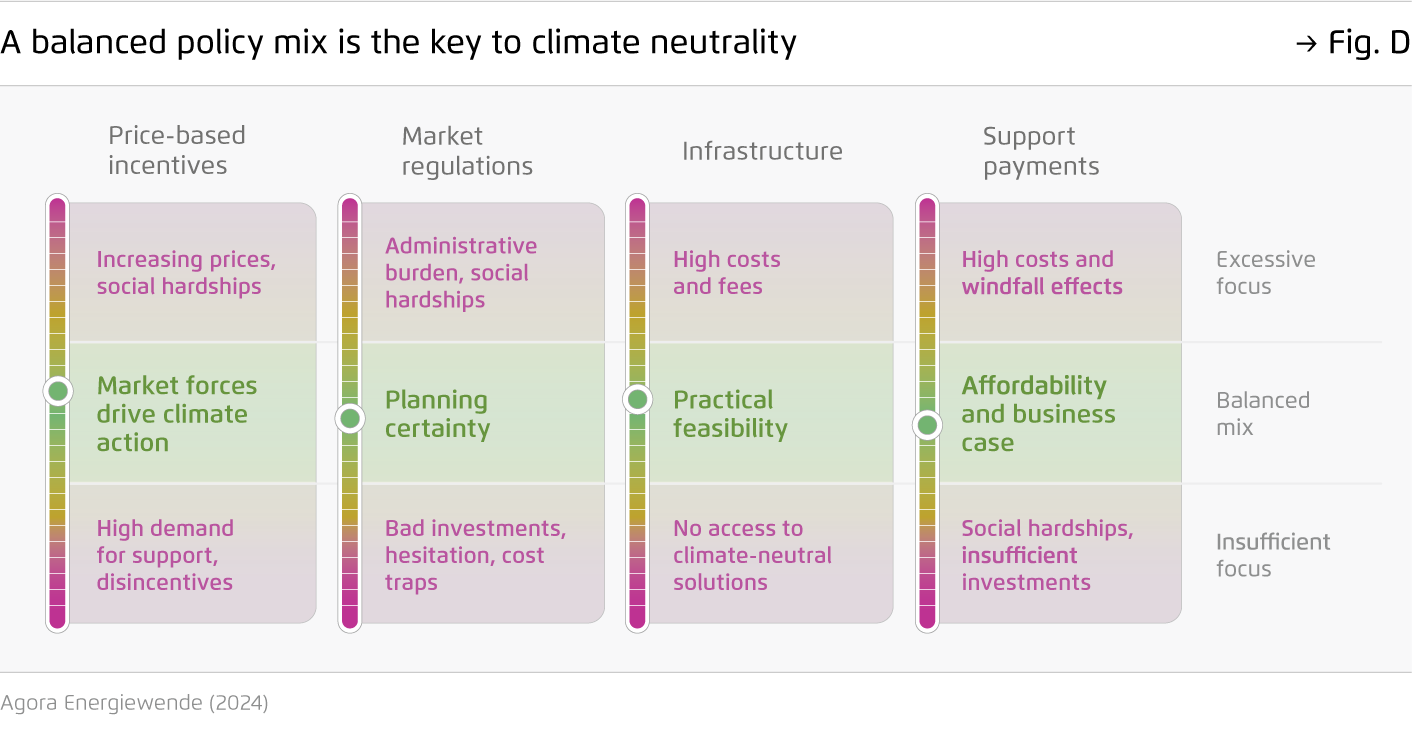
Under consideration of the Creative Commons license CC BY (attribution) the image may be further processed in any format or medium (also commercially, also in modified form), as long as the author is mentioned and a link to the license is given.
Measures in the climate-neutral Germany 2024 scenario
Figure 5 from Climate-neutral Germany on page 16
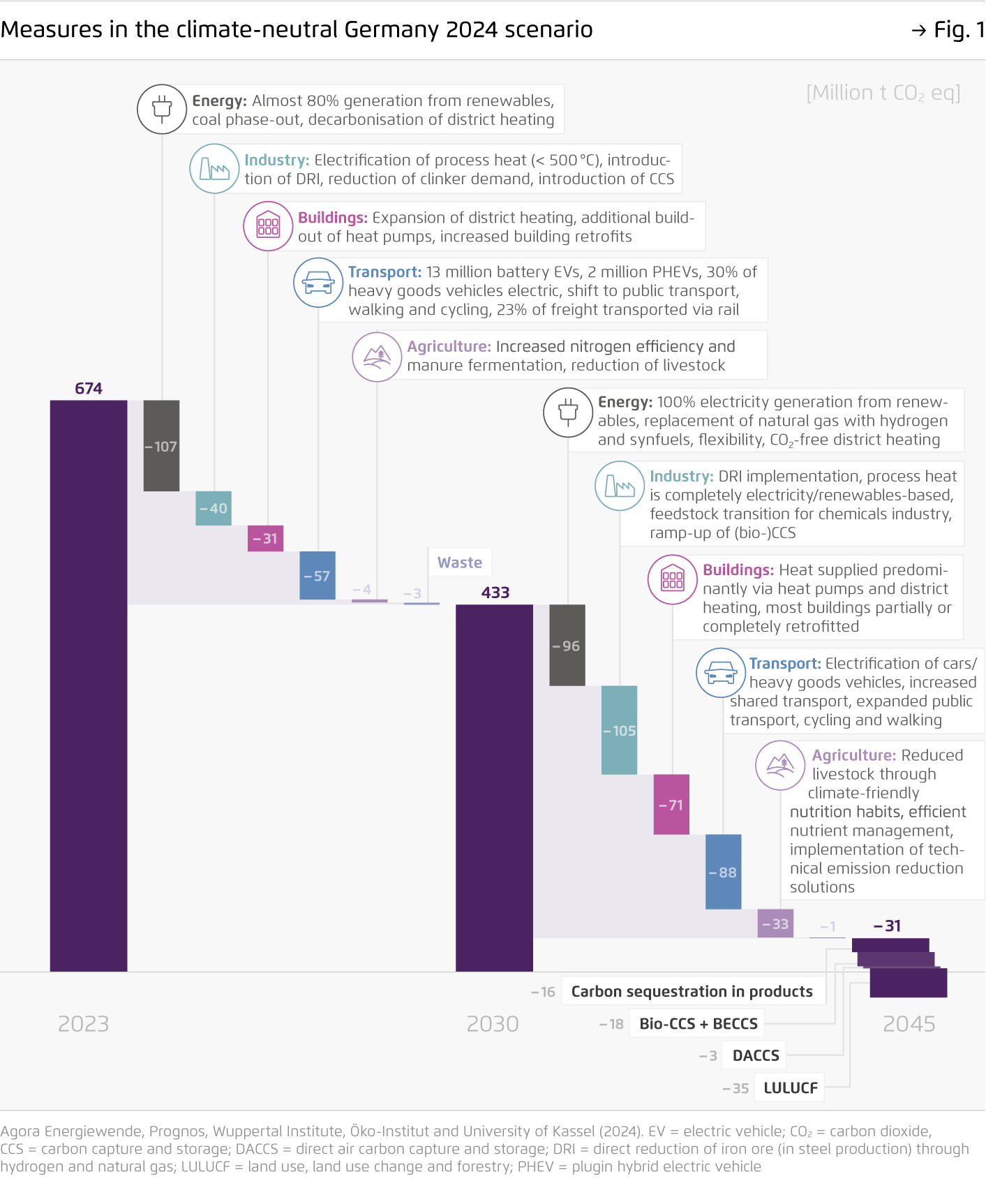
Under consideration of the Creative Commons license CC BY (attribution) the image may be further processed in any format or medium (also commercially, also in modified form), as long as the author is mentioned and a link to the license is given.
Greenhouse gas emission reduction pathways by sector, until 2045
Figure 6 from Climate-neutral Germany on page 18
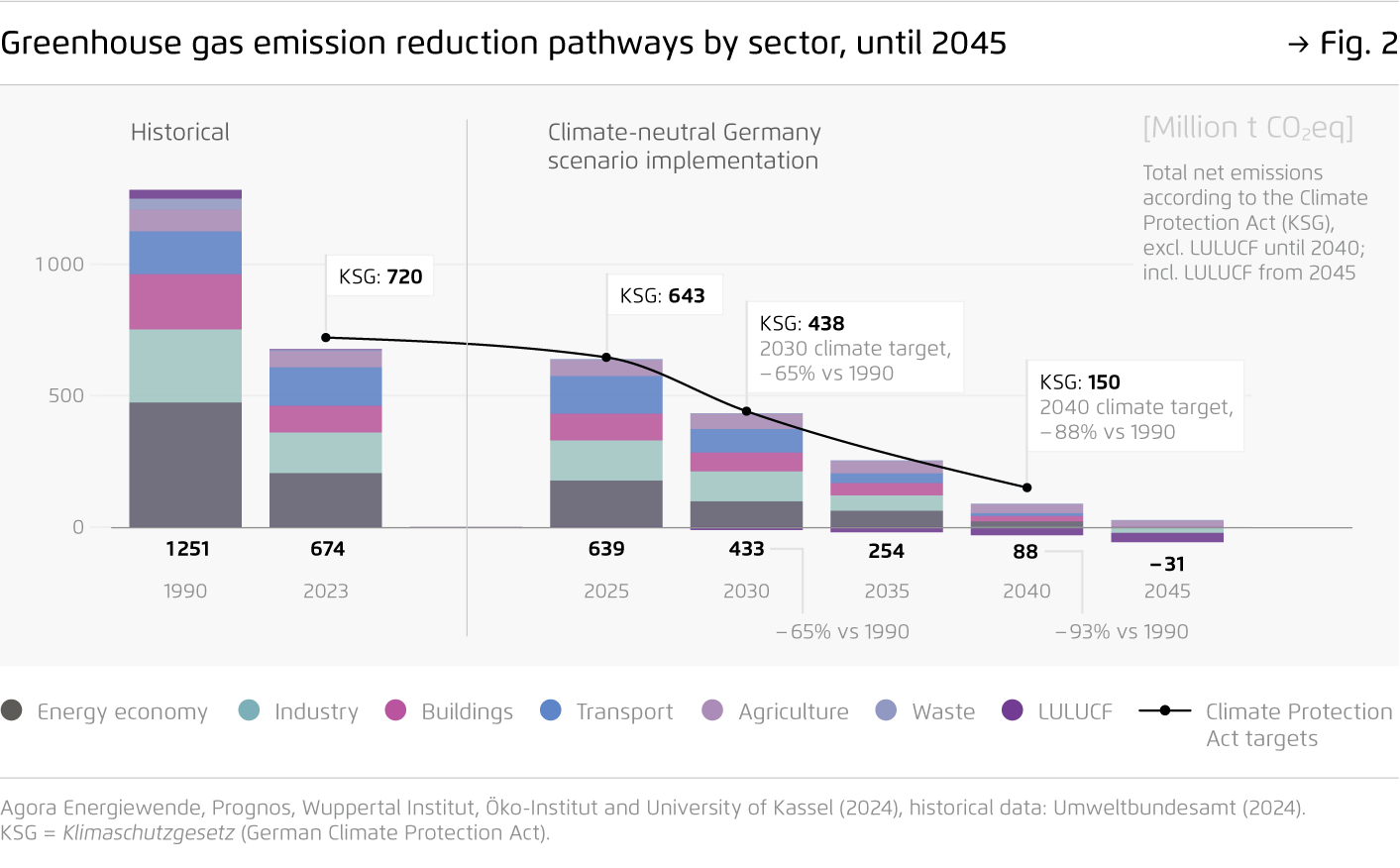
Under consideration of the Creative Commons license CC BY (attribution) the image may be further processed in any format or medium (also commercially, also in modified form), as long as the author is mentioned and a link to the license is given.
The average annual investment volume is 11.2 percent of the gross domestic product (GDP)
Figure 7 from Climate-neutral Germany on page 19
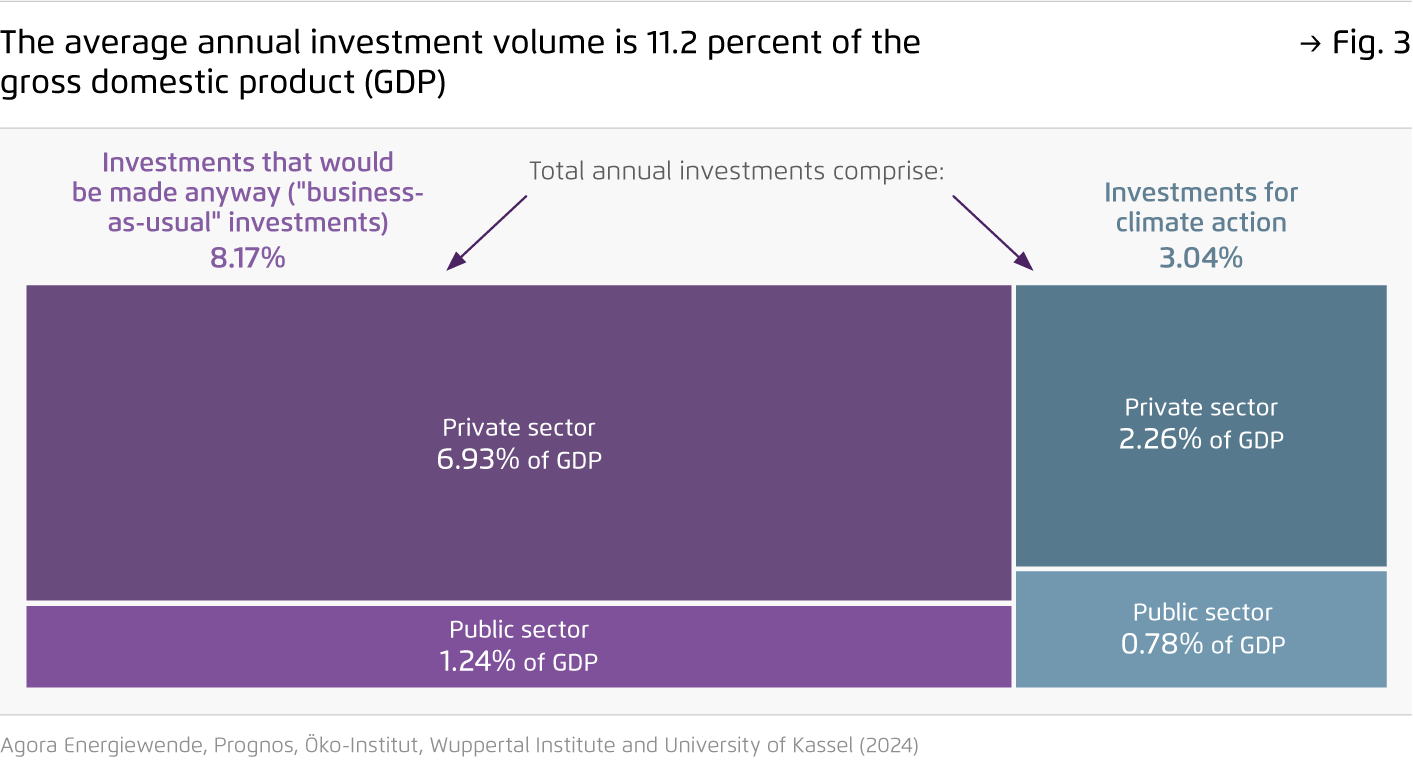
Under consideration of the Creative Commons license CC BY (attribution) the image may be further processed in any format or medium (also commercially, also in modified form), as long as the author is mentioned and a link to the license is given.
Total and climate protection investments in the sectors as a share of gross domestic product
Figure 8 from Climate-neutral Germany on page 19
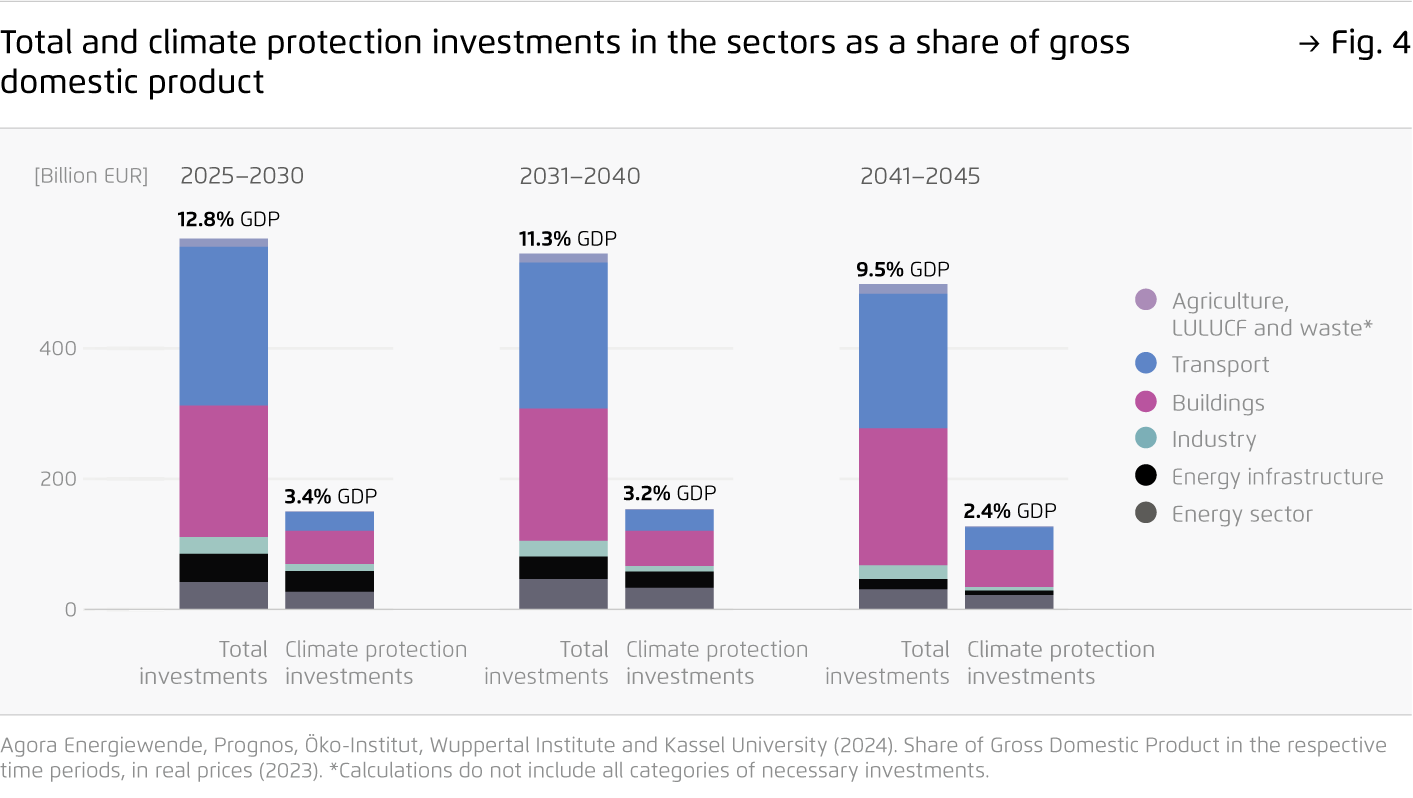
Under consideration of the Creative Commons license CC BY (attribution) the image may be further processed in any format or medium (also commercially, also in modified form), as long as the author is mentioned and a link to the license is given.
A balanced policy mix is the key to climate neutrality
Figure 9 from Climate-neutral Germany on page 23
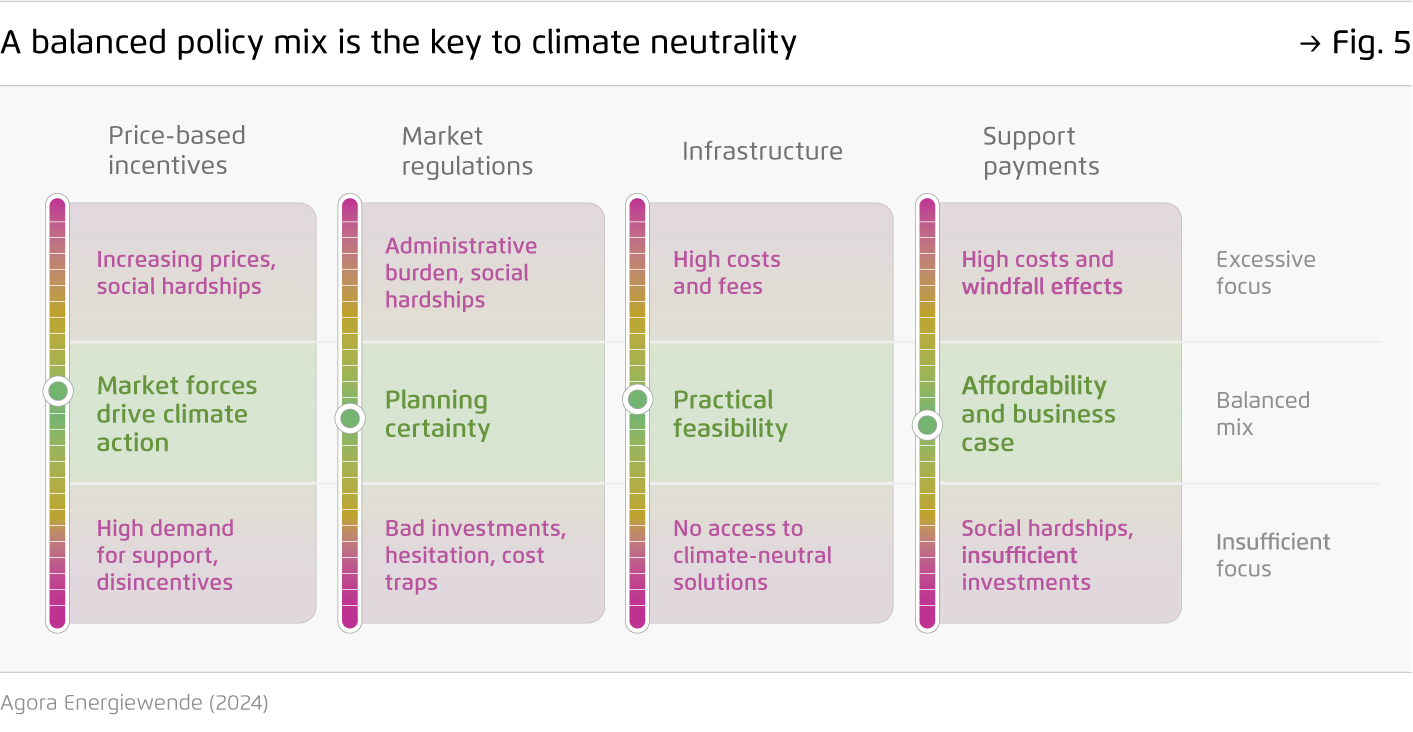
Under consideration of the Creative Commons license CC BY (attribution) the image may be further processed in any format or medium (also commercially, also in modified form), as long as the author is mentioned and a link to the license is given.
Energy sector – reduction of greenhouse gas emissions
Figure 10 from Climate-neutral Germany on page 24
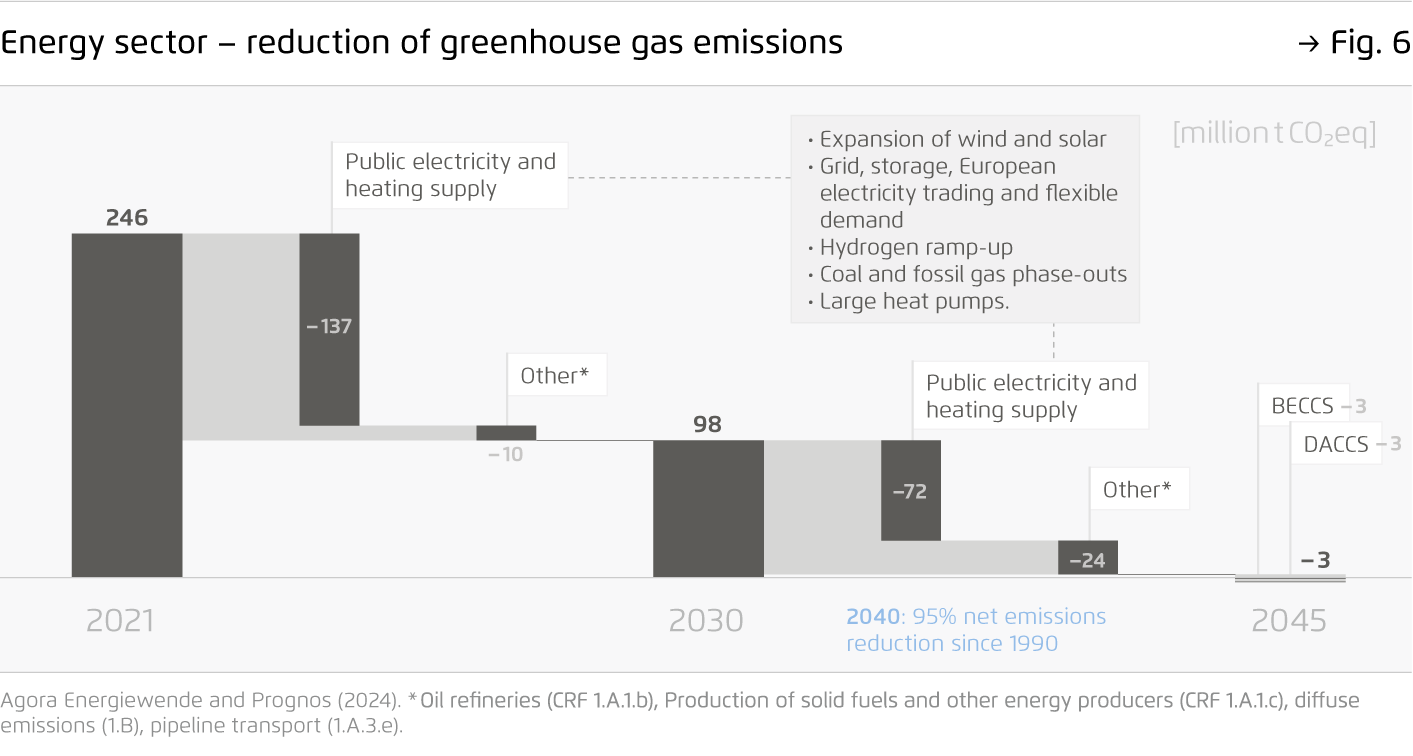
Under consideration of the Creative Commons license CC BY (attribution) the image may be further processed in any format or medium (also commercially, also in modified form), as long as the author is mentioned and a link to the license is given.
Reduction in net imports of energy sources up to 2045
Figure 11 from Climate-neutral Germany on page 25
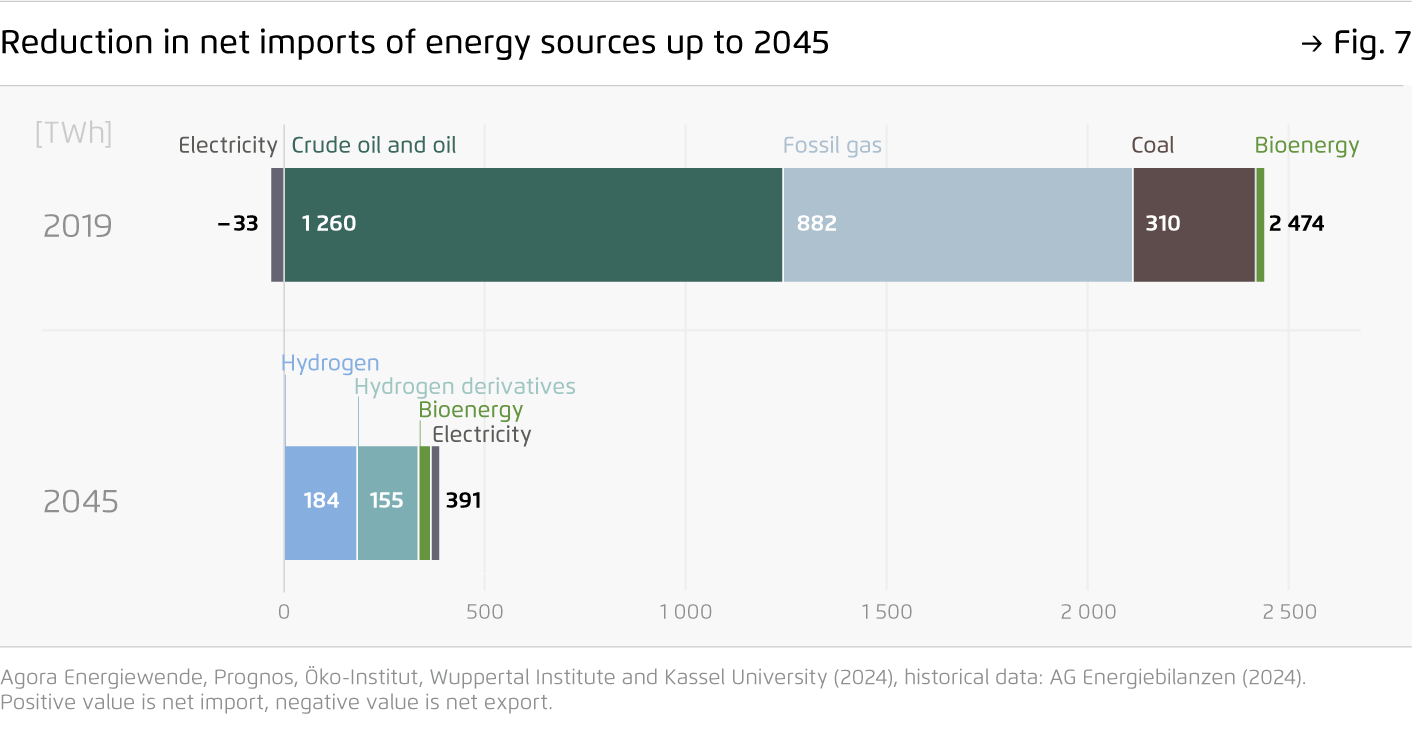
Under consideration of the Creative Commons license CC BY (attribution) the image may be further processed in any format or medium (also commercially, also in modified form), as long as the author is mentioned and a link to the license is given.
Specific electricity system costs up to 2045
Figure 12 from Climate-neutral Germany on page 25
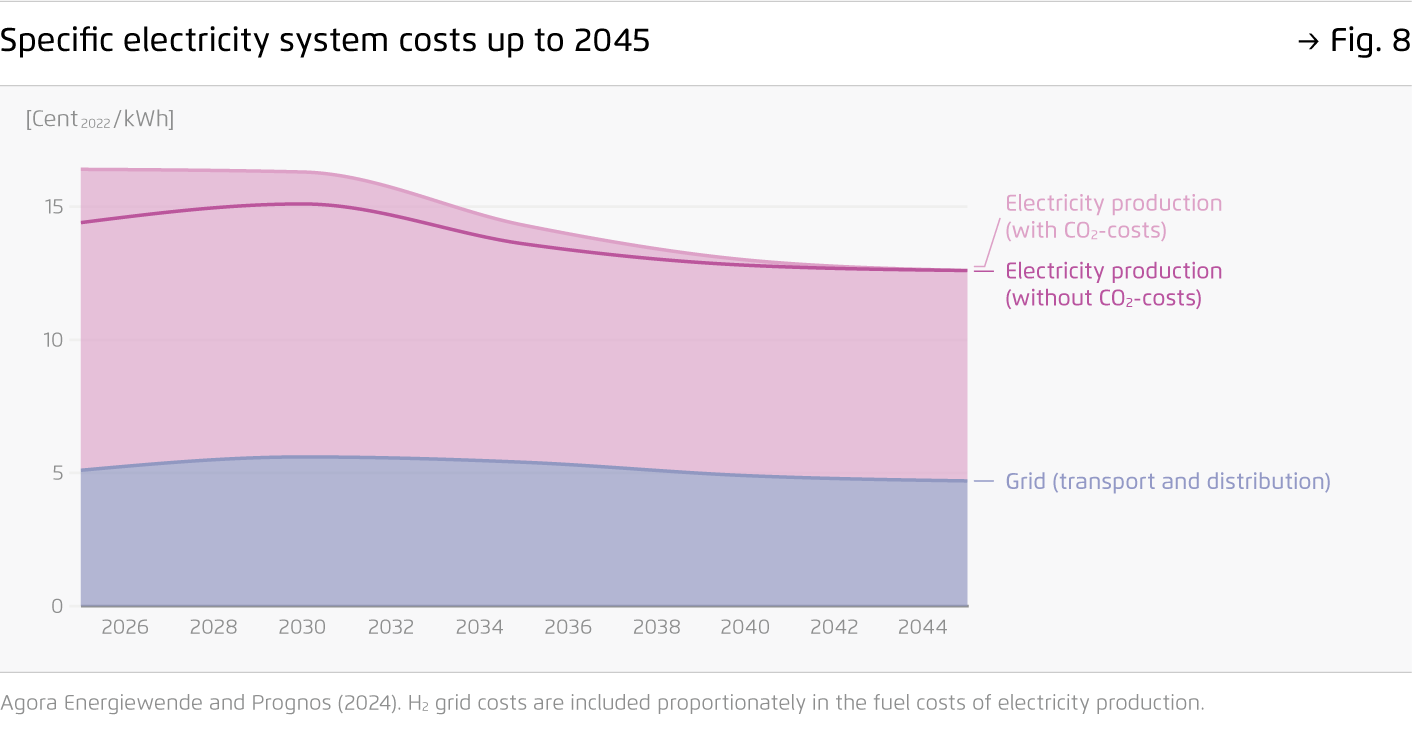
Under consideration of the Creative Commons license CC BY (attribution) the image may be further processed in any format or medium (also commercially, also in modified form), as long as the author is mentioned and a link to the license is given.
Installed capacity
Figure 13 from Climate-neutral Germany on page 26
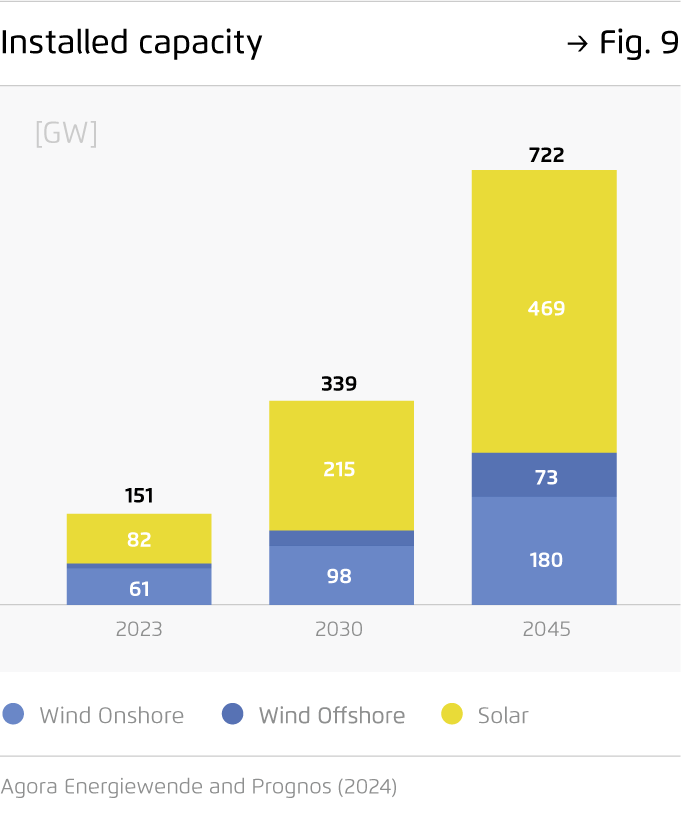
Under consideration of the Creative Commons license CC BY (attribution) the image may be further processed in any format or medium (also commercially, also in modified form), as long as the author is mentioned and a link to the license is given.
Energy sector – key policy instruments
Figure 14 from Climate-neutral Germany on page 27
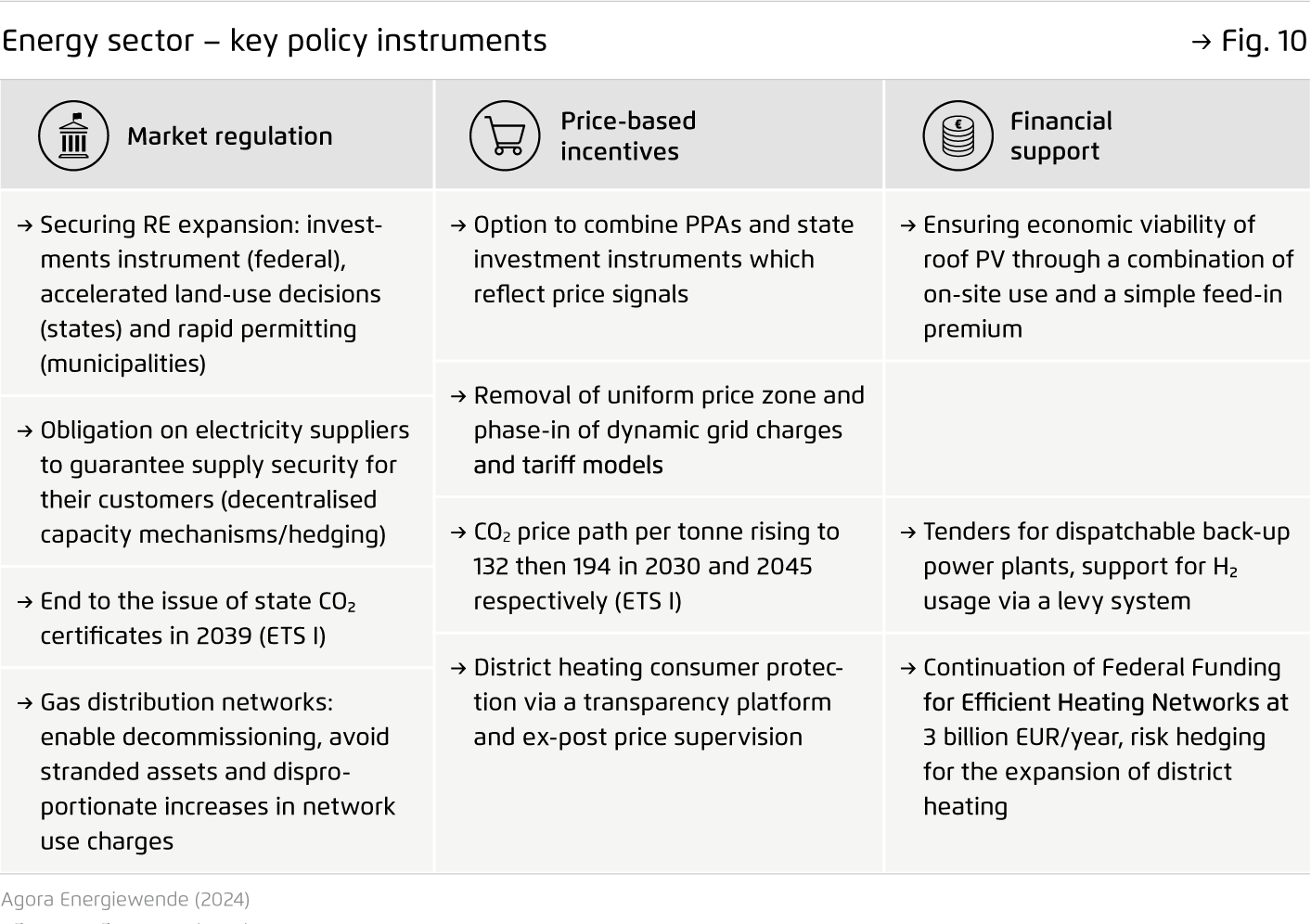
Under consideration of the Creative Commons license CC BY (attribution) the image may be further processed in any format or medium (also commercially, also in modified form), as long as the author is mentioned and a link to the license is given.
Electricity demand by sector
Figure 15 from Climate-neutral Germany on page 29
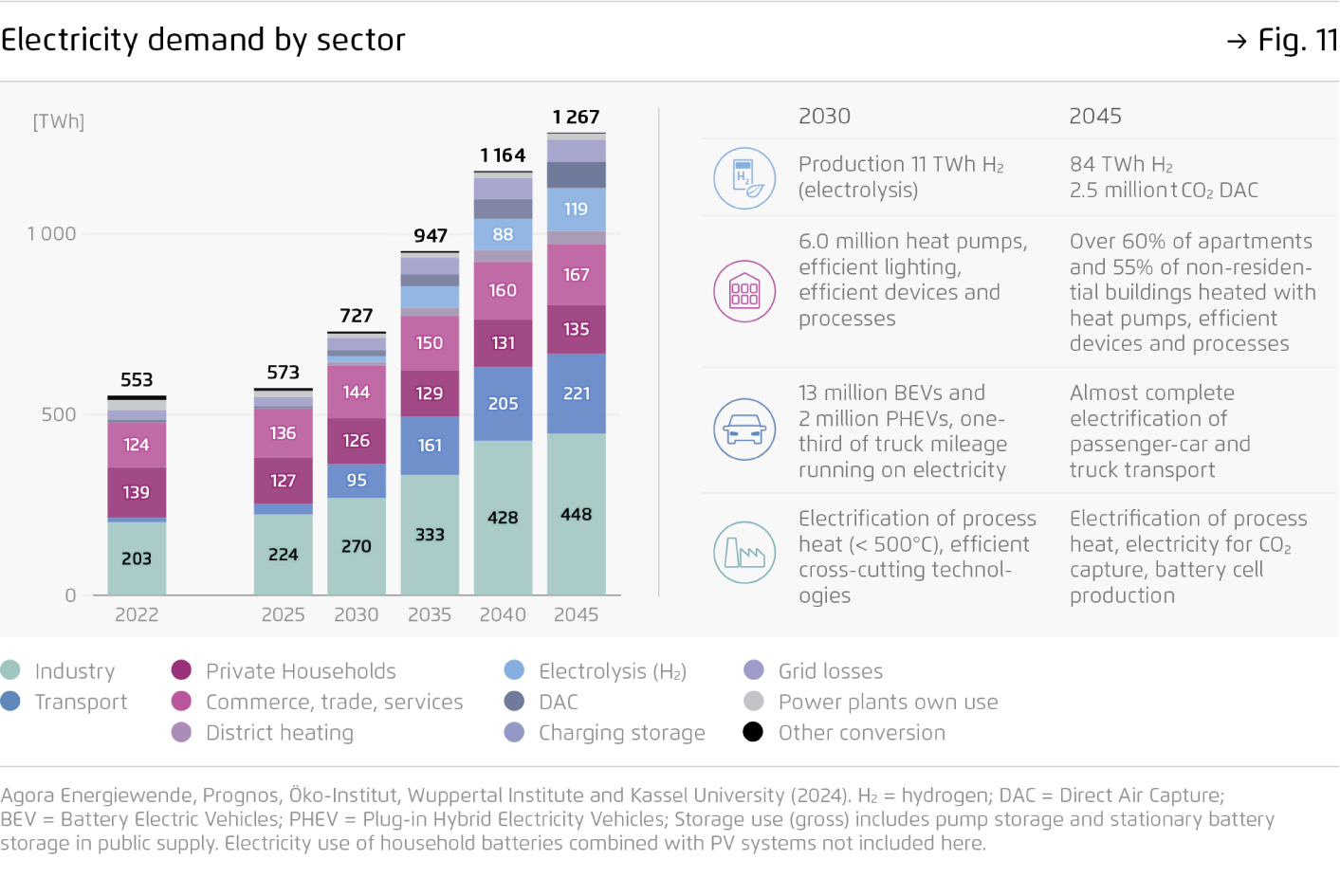
Under consideration of the Creative Commons license CC BY (attribution) the image may be further processed in any format or medium (also commercially, also in modified form), as long as the author is mentioned and a link to the license is given.
Net electricity production
Figure 16 from Climate-neutral Germany on page 30
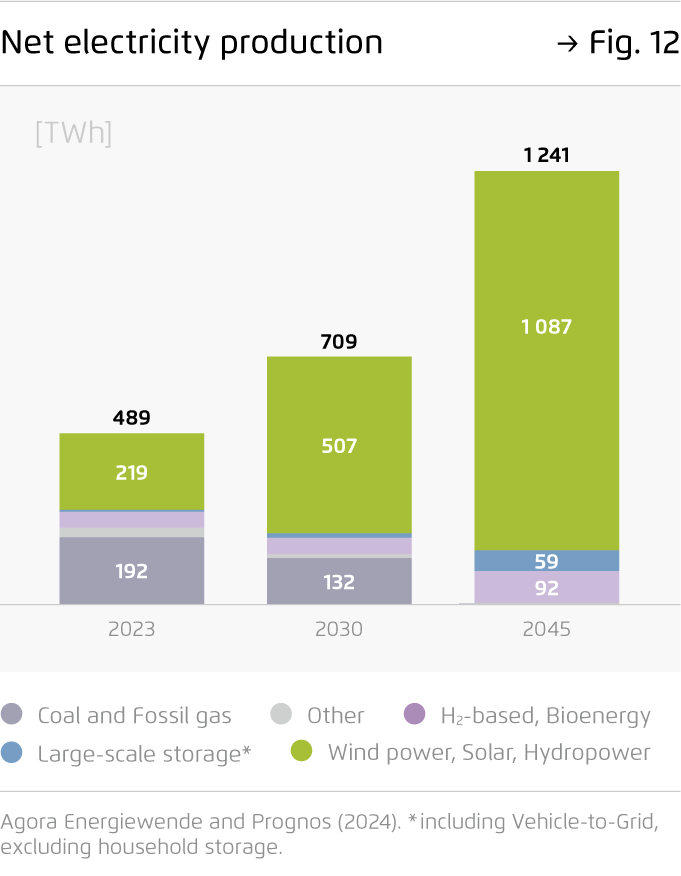
Under consideration of the Creative Commons license CC BY (attribution) the image may be further processed in any format or medium (also commercially, also in modified form), as long as the author is mentioned and a link to the license is given.
Industrial sector – reduction of greenhouse gas emissions
Figure 17 from Climate-neutral Germany on page 31
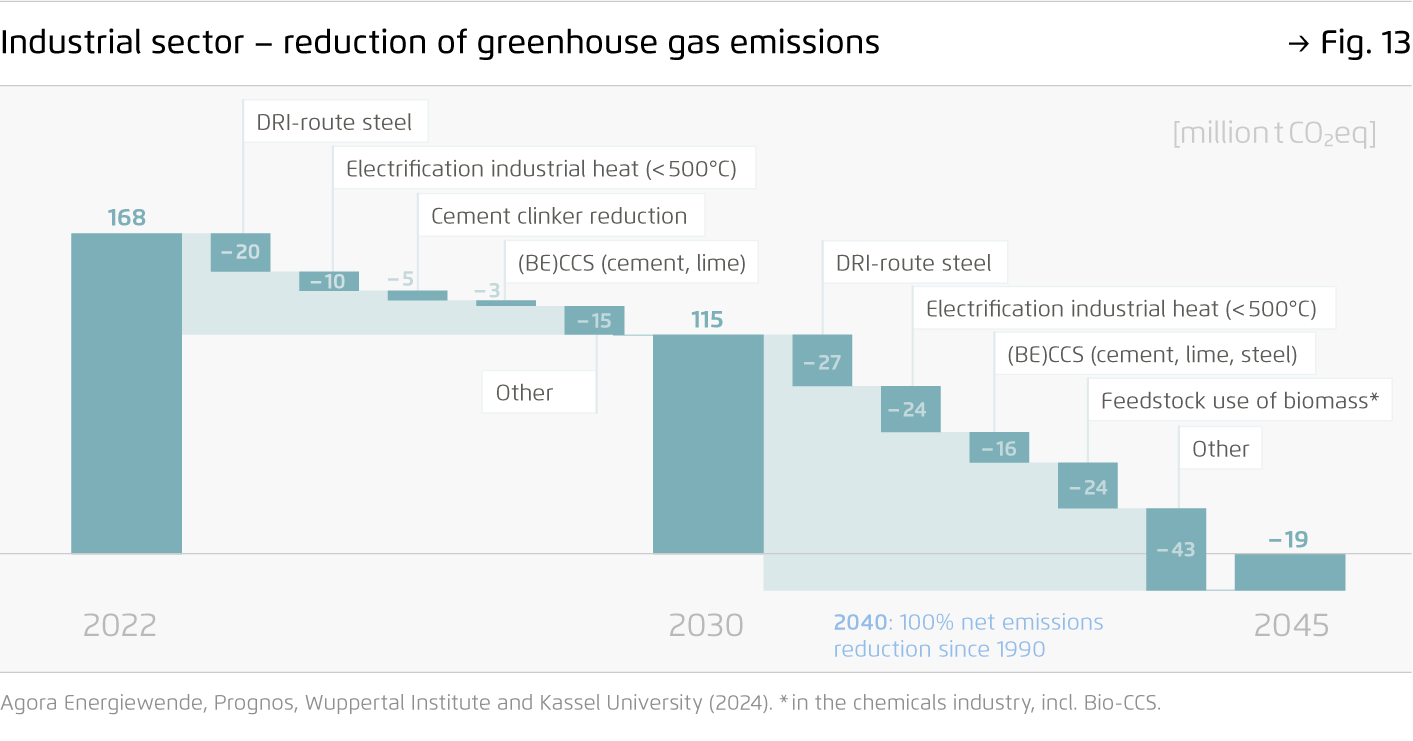
Under consideration of the Creative Commons license CC BY (attribution) the image may be further processed in any format or medium (also commercially, also in modified form), as long as the author is mentioned and a link to the license is given.
Roll-out of industrial heat pumps
Figure 18 from Climate-neutral Germany on page 32
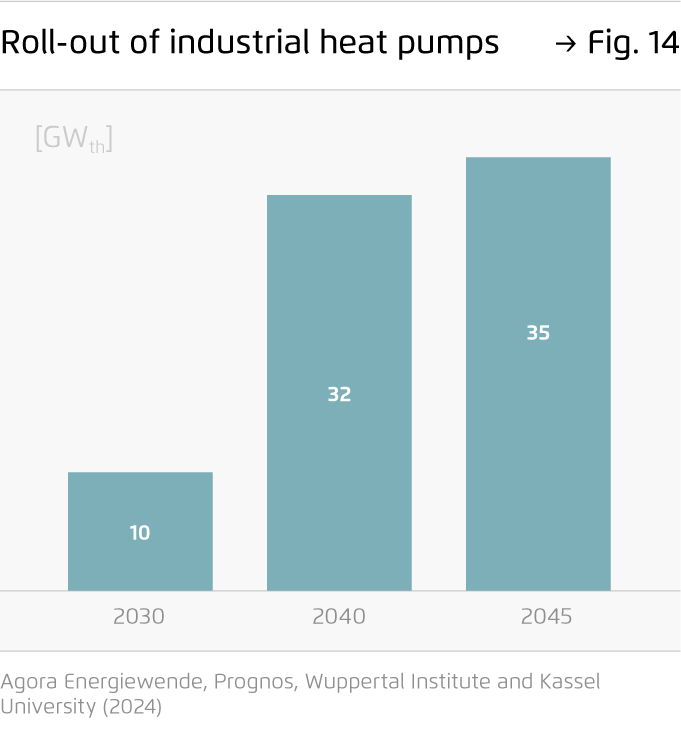
Under consideration of the Creative Commons license CC BY (attribution) the image may be further processed in any format or medium (also commercially, also in modified form), as long as the author is mentioned and a link to the license is given.
Industrial sector – key policy instruments
Figure 19 from Climate-neutral Germany on page 33
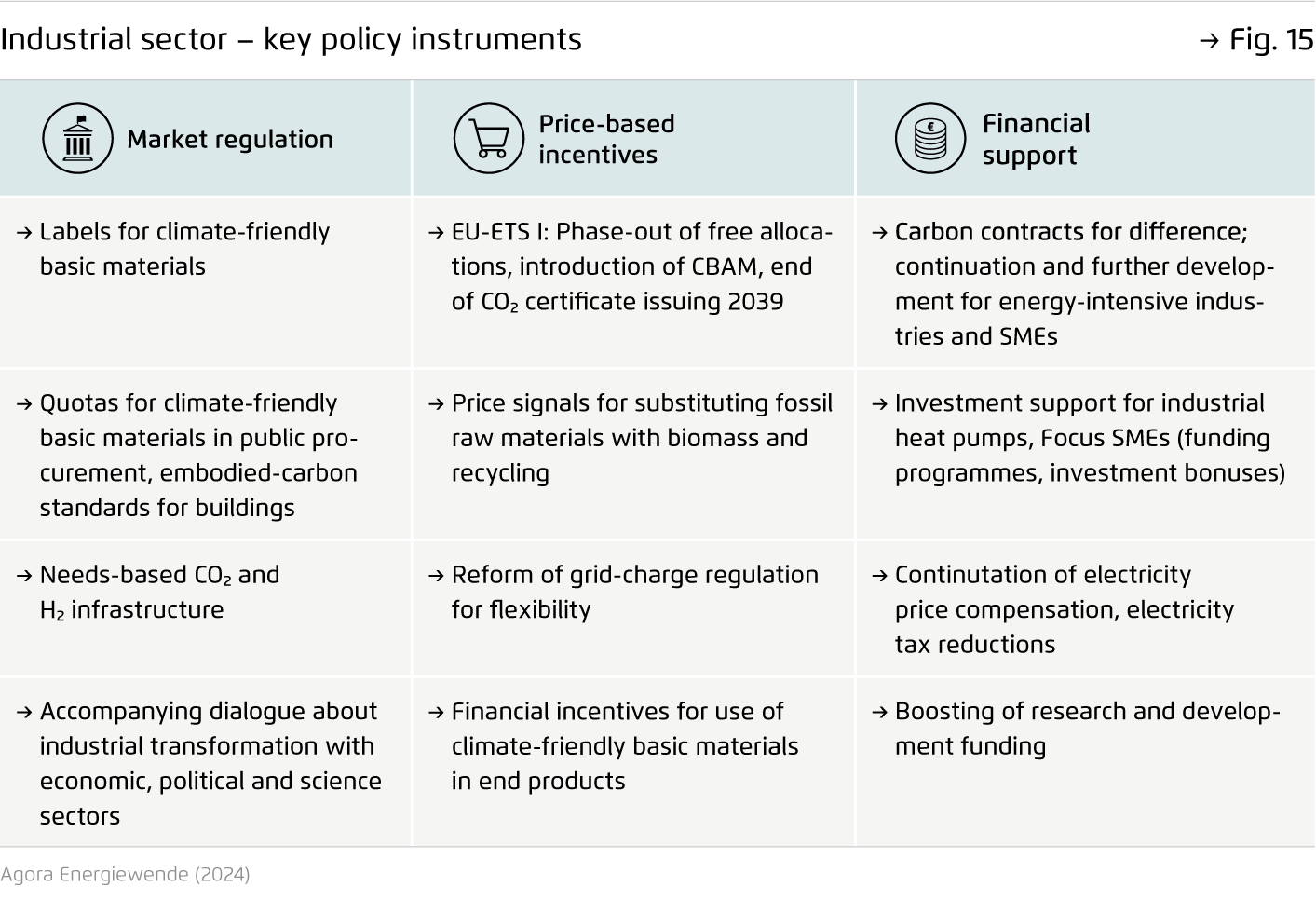
Under consideration of the Creative Commons license CC BY (attribution) the image may be further processed in any format or medium (also commercially, also in modified form), as long as the author is mentioned and a link to the license is given.
Final energy consumption by energy source in the industrial sector
Figure 20 from Climate-neutral Germany on page 34
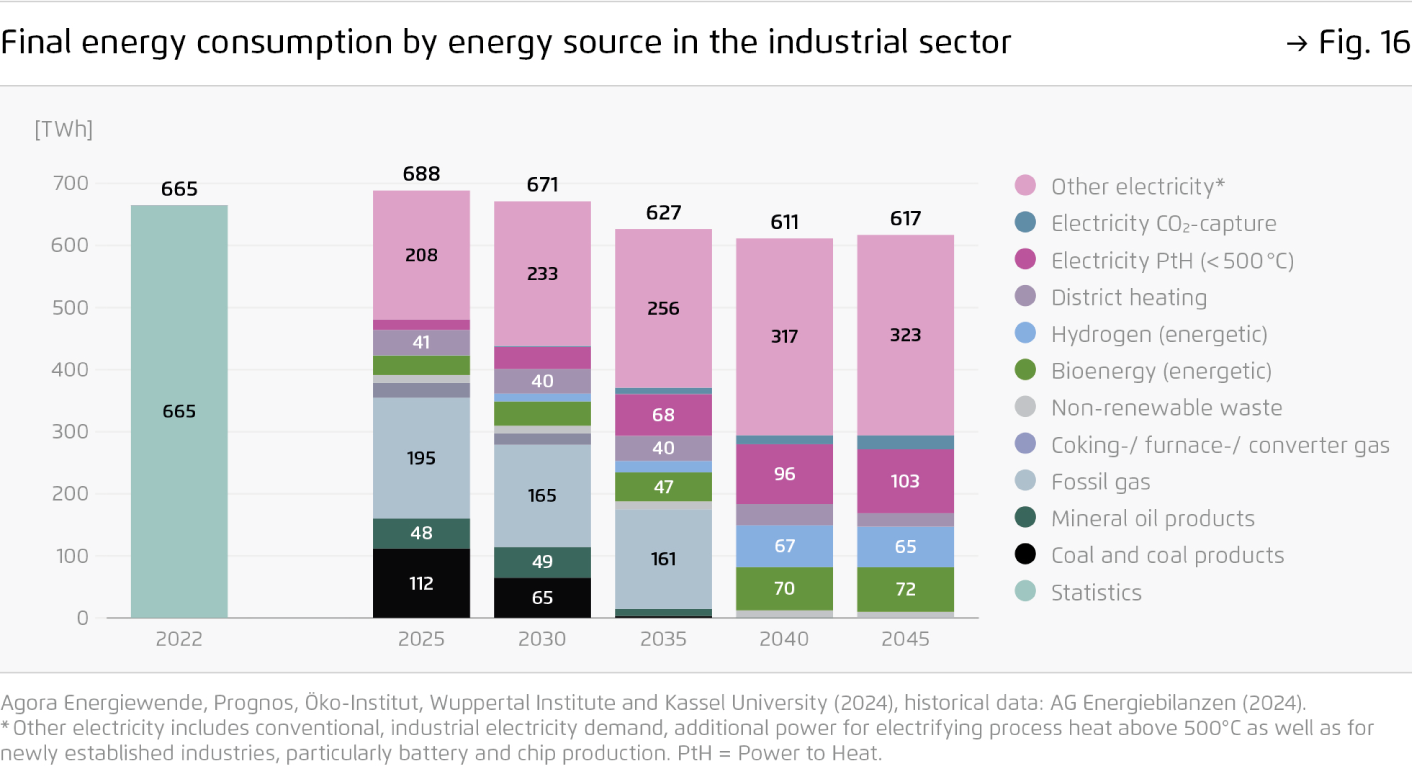
Under consideration of the Creative Commons license CC BY (attribution) the image may be further processed in any format or medium (also commercially, also in modified form), as long as the author is mentioned and a link to the license is given.
Availability of low-emissions* basic materials
Figure 21 from Climate-neutral Germany on page 36
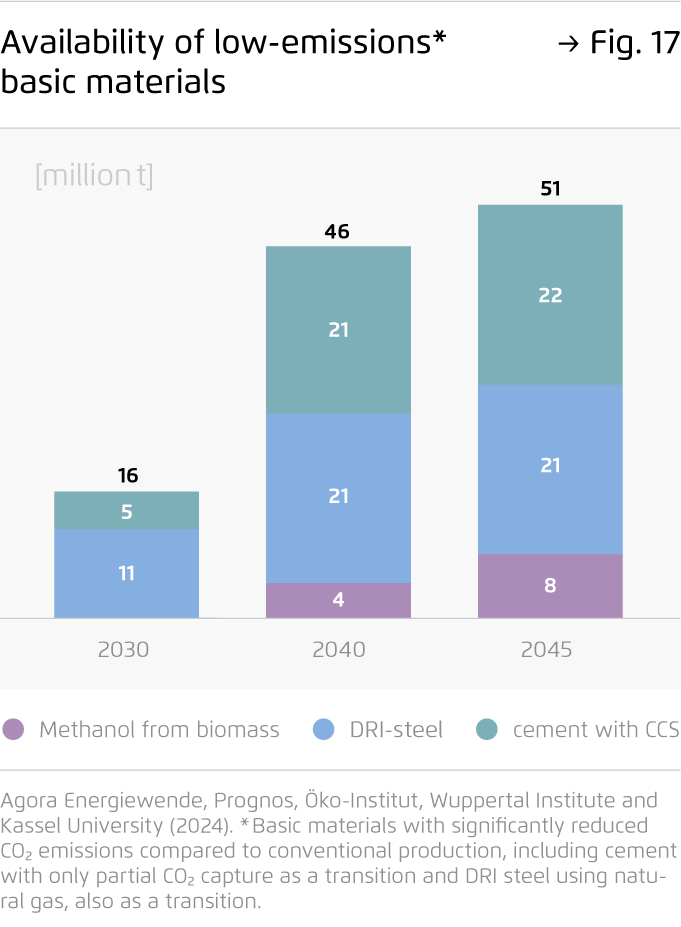
Under consideration of the Creative Commons license CC BY (attribution) the image may be further processed in any format or medium (also commercially, also in modified form), as long as the author is mentioned and a link to the license is given.
Buildings sector – reduction of greenhouse gas emissions
Figure 22 from Climate-neutral Germany on page 37
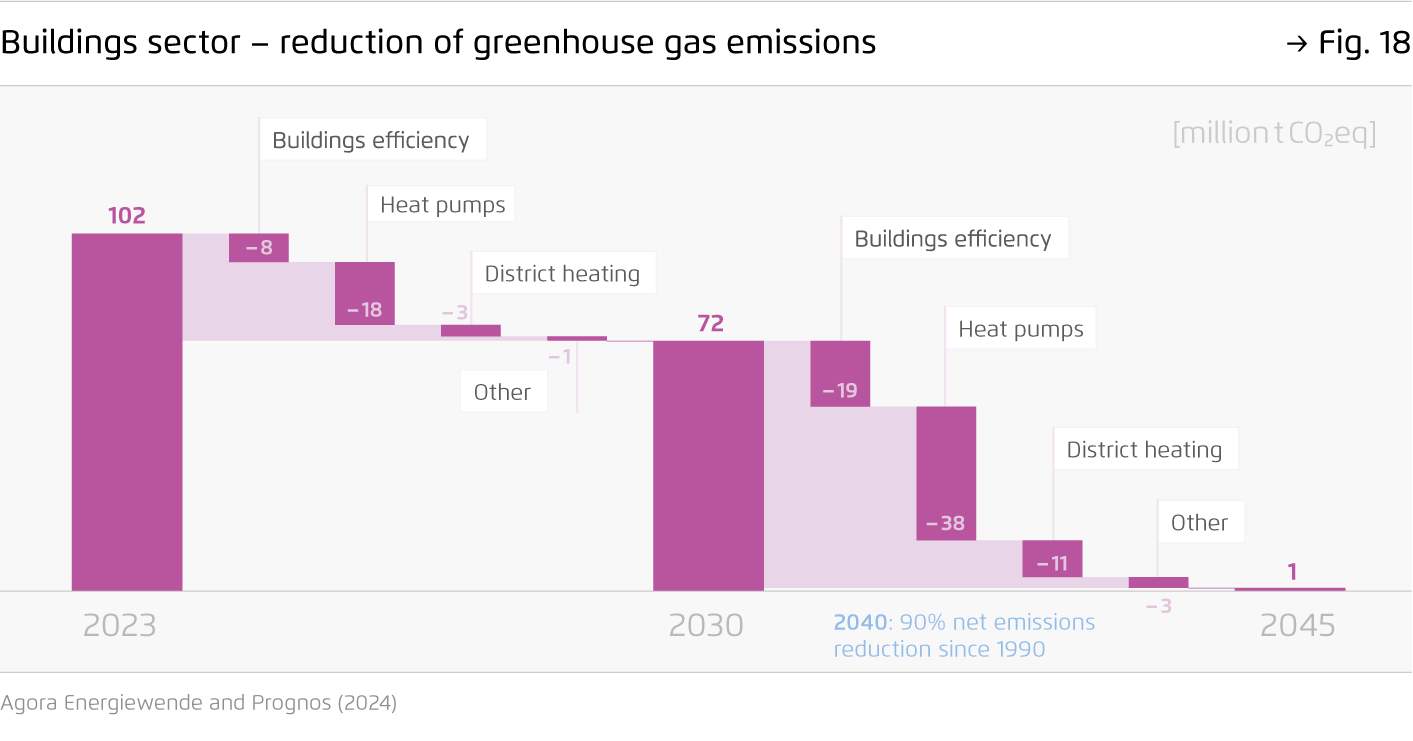
Under consideration of the Creative Commons license CC BY (attribution) the image may be further processed in any format or medium (also commercially, also in modified form), as long as the author is mentioned and a link to the license is given.
Heating structure in building stock
Figure 23 from Climate-neutral Germany on page 38
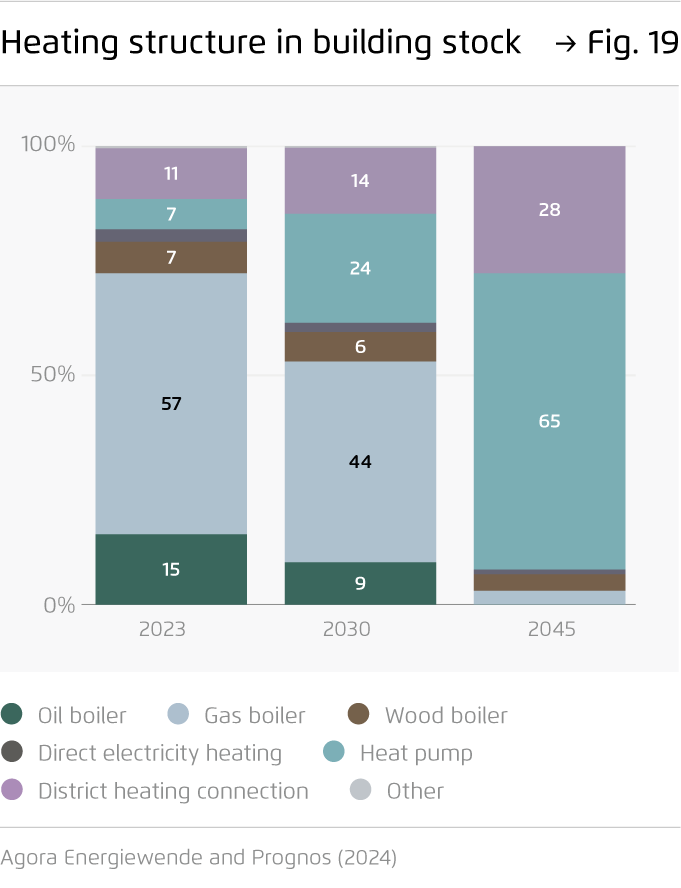
Under consideration of the Creative Commons license CC BY (attribution) the image may be further processed in any format or medium (also commercially, also in modified form), as long as the author is mentioned and a link to the license is given.
Buildings sector – key policy instruments
Figure 24 from Climate-neutral Germany on page 40
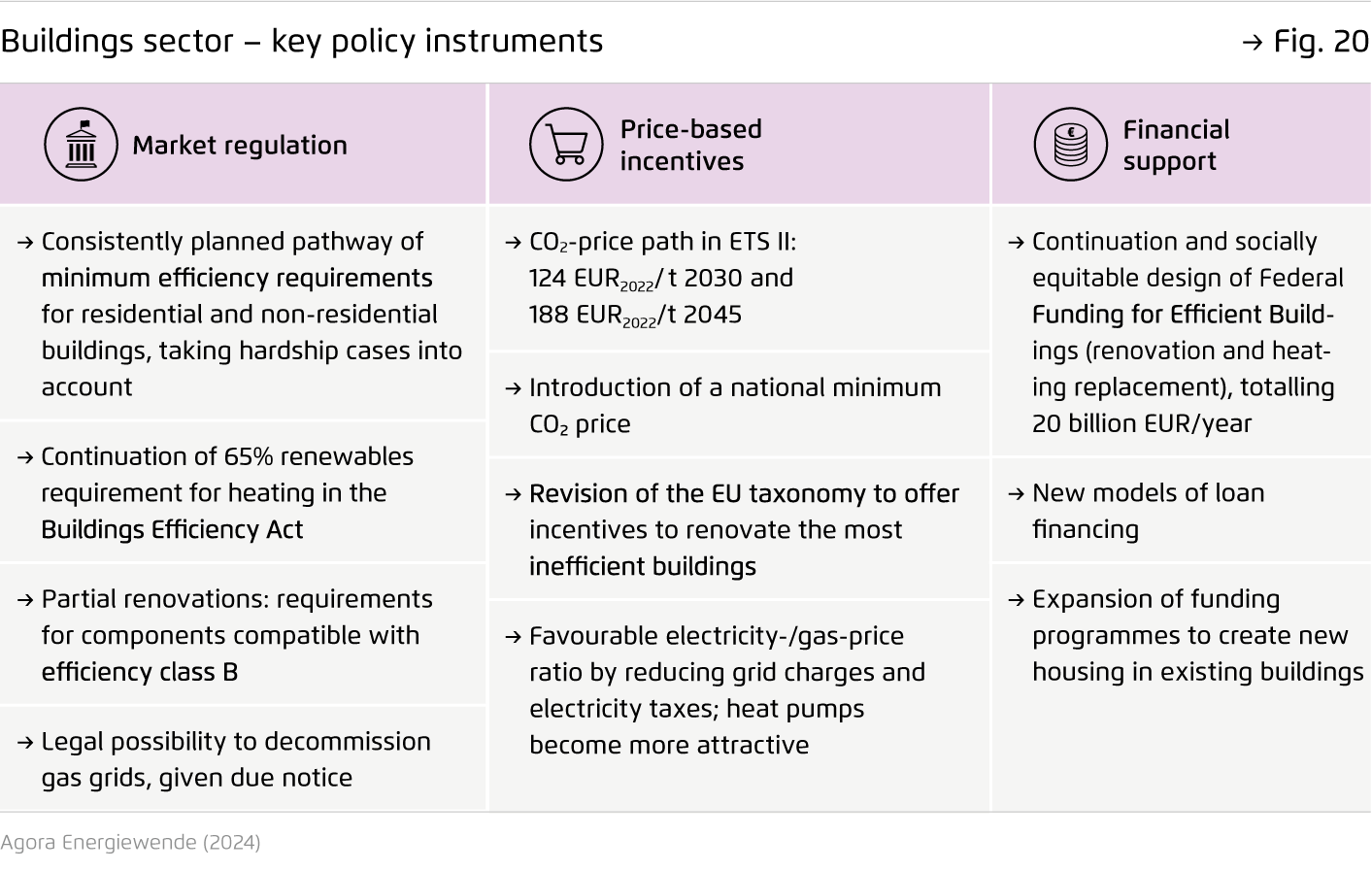
Under consideration of the Creative Commons license CC BY (attribution) the image may be further processed in any format or medium (also commercially, also in modified form), as long as the author is mentioned and a link to the license is given.
Specific final energy demand in building stock
Figure 25 from Climate-neutral Germany on page 41
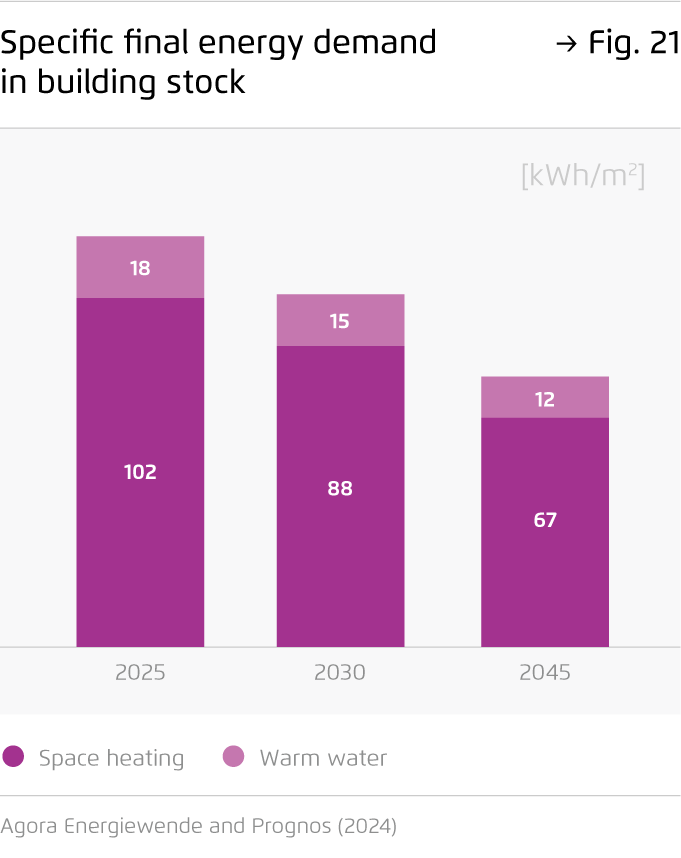
Under consideration of the Creative Commons license CC BY (attribution) the image may be further processed in any format or medium (also commercially, also in modified form), as long as the author is mentioned and a link to the license is given.
Final energy consumption by energy source in the buildings sector
Figure 26 from Climate-neutral Germany on page 42
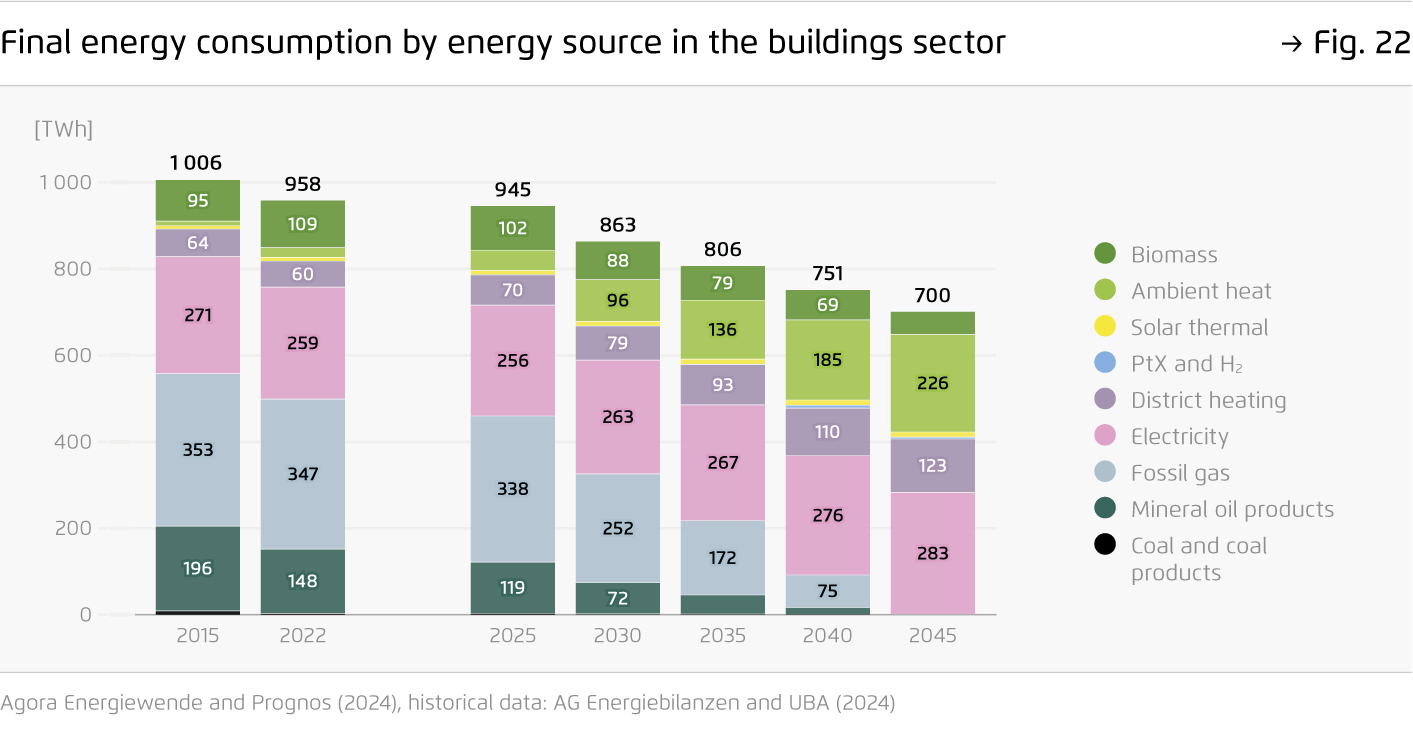
Under consideration of the Creative Commons license CC BY (attribution) the image may be further processed in any format or medium (also commercially, also in modified form), as long as the author is mentioned and a link to the license is given.
Transport sector – reduction of greenhouse gas emissions
Figure 27 from Climate-neutral Germany on page 43
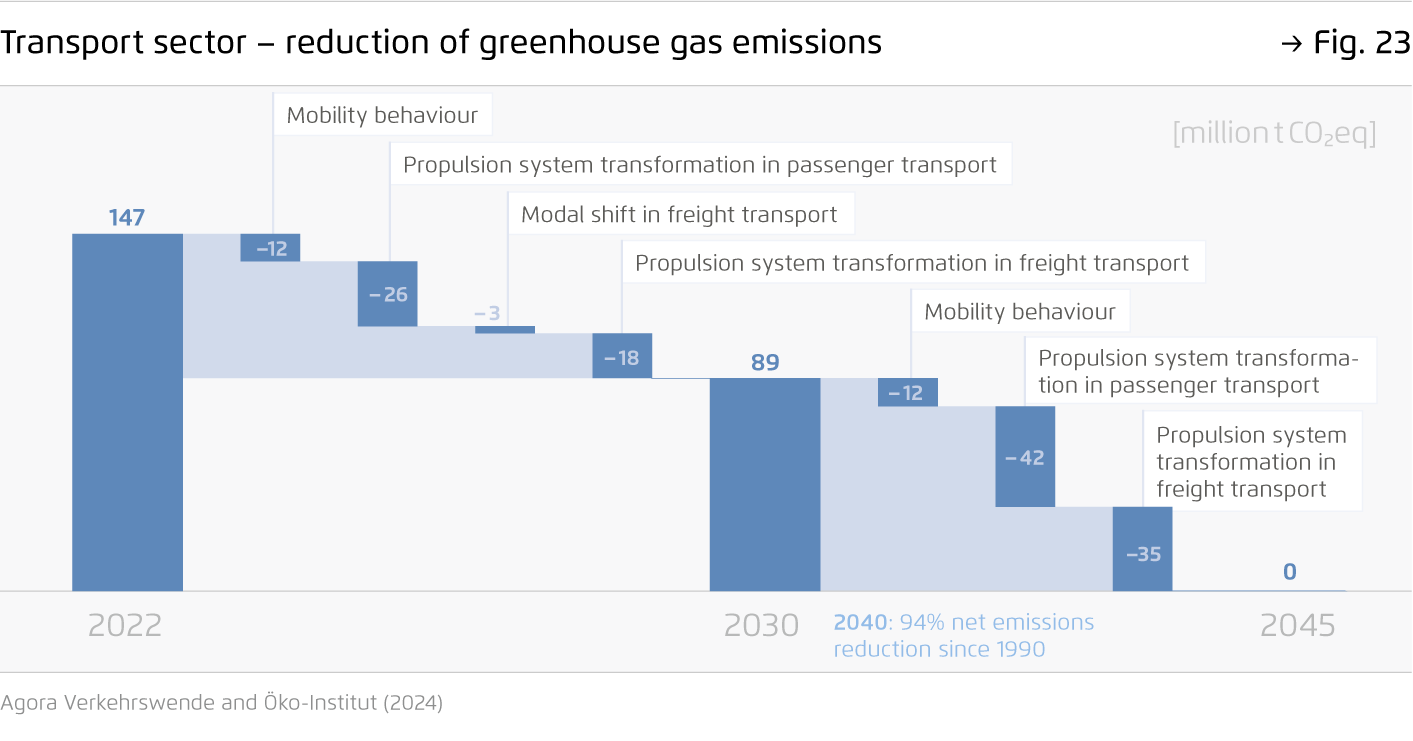
Under consideration of the Creative Commons license CC BY (attribution) the image may be further processed in any format or medium (also commercially, also in modified form), as long as the author is mentioned and a link to the license is given.
Stock of fully electric passenger cars
Figure 28 from Climate-neutral Germany on page 43
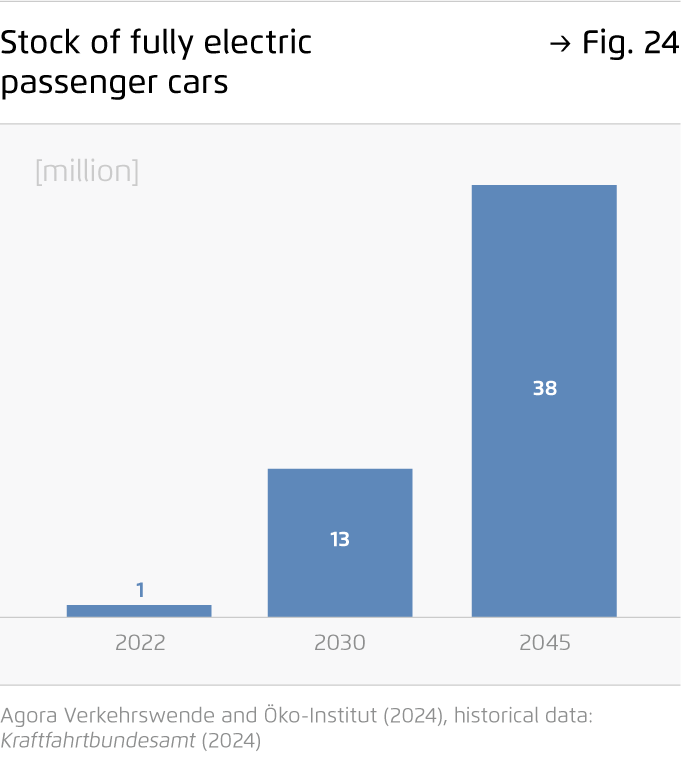
Under consideration of the Creative Commons license CC BY (attribution) the image may be further processed in any format or medium (also commercially, also in modified form), as long as the author is mentioned and a link to the license is given.
Share of electric-powered mileage in road freight transport
Figure 29 from Climate-neutral Germany on page 44
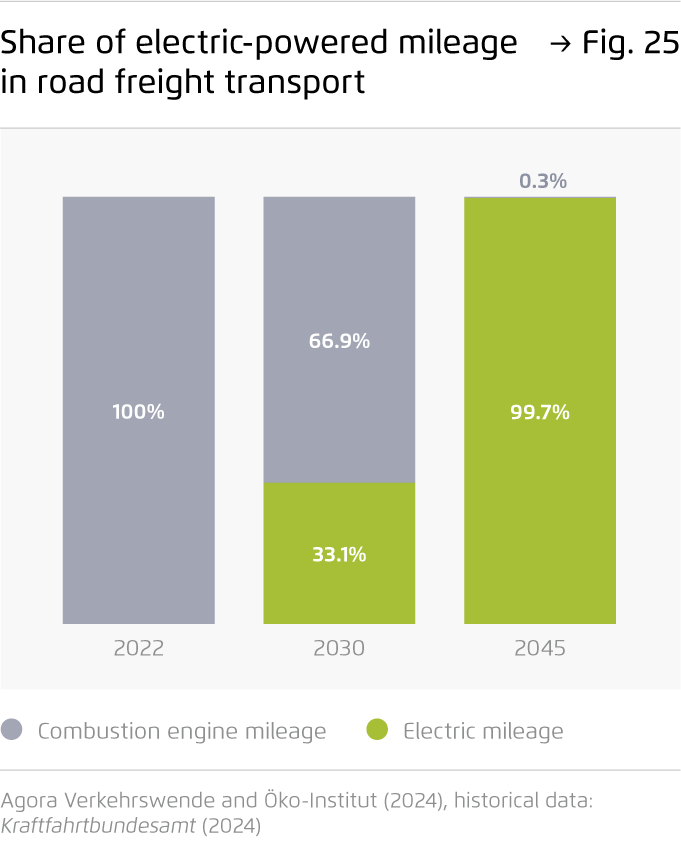
Under consideration of the Creative Commons license CC BY (attribution) the image may be further processed in any format or medium (also commercially, also in modified form), as long as the author is mentioned and a link to the license is given.
Transport sector – key policy instruments
Figure 30 from Climate-neutral Germany on page 45
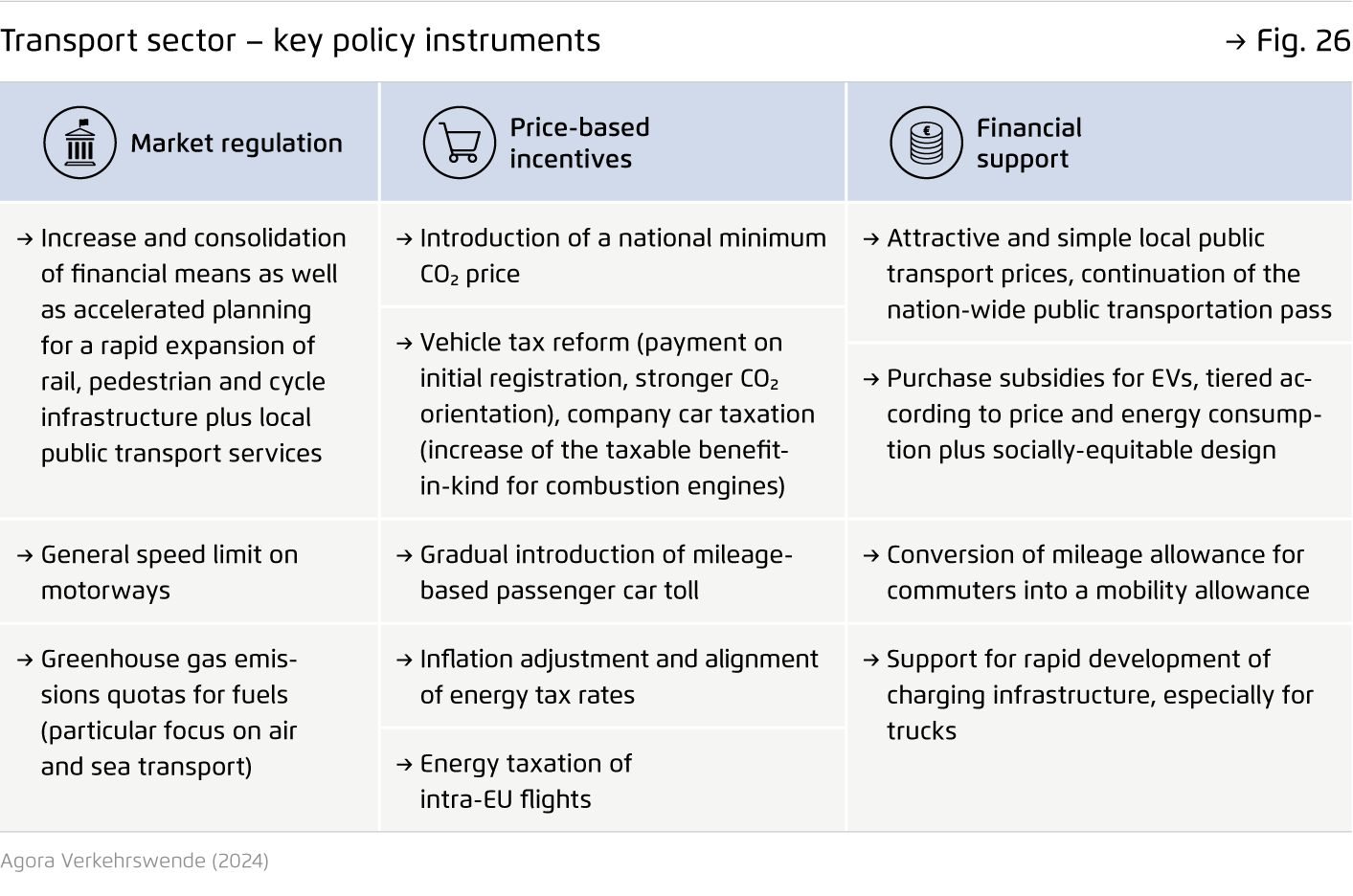
Under consideration of the Creative Commons license CC BY (attribution) the image may be further processed in any format or medium (also commercially, also in modified form), as long as the author is mentioned and a link to the license is given.
Development of passenger transport demand
Figure 31 from Climate-neutral Germany on page 46
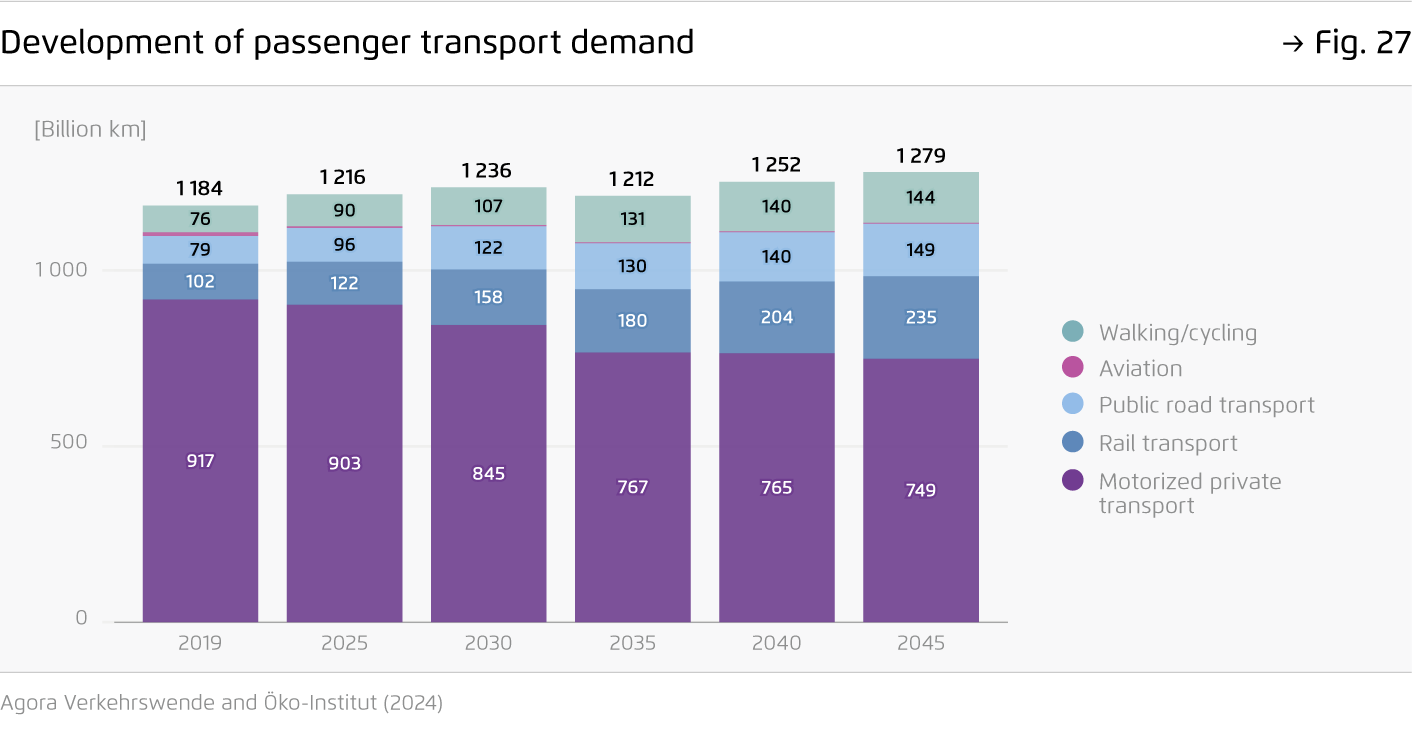
Under consideration of the Creative Commons license CC BY (attribution) the image may be further processed in any format or medium (also commercially, also in modified form), as long as the author is mentioned and a link to the license is given.
Agriculture sector – reduction of greenhouse gas emissions
Figure 32 from Climate-neutral Germany on page 47
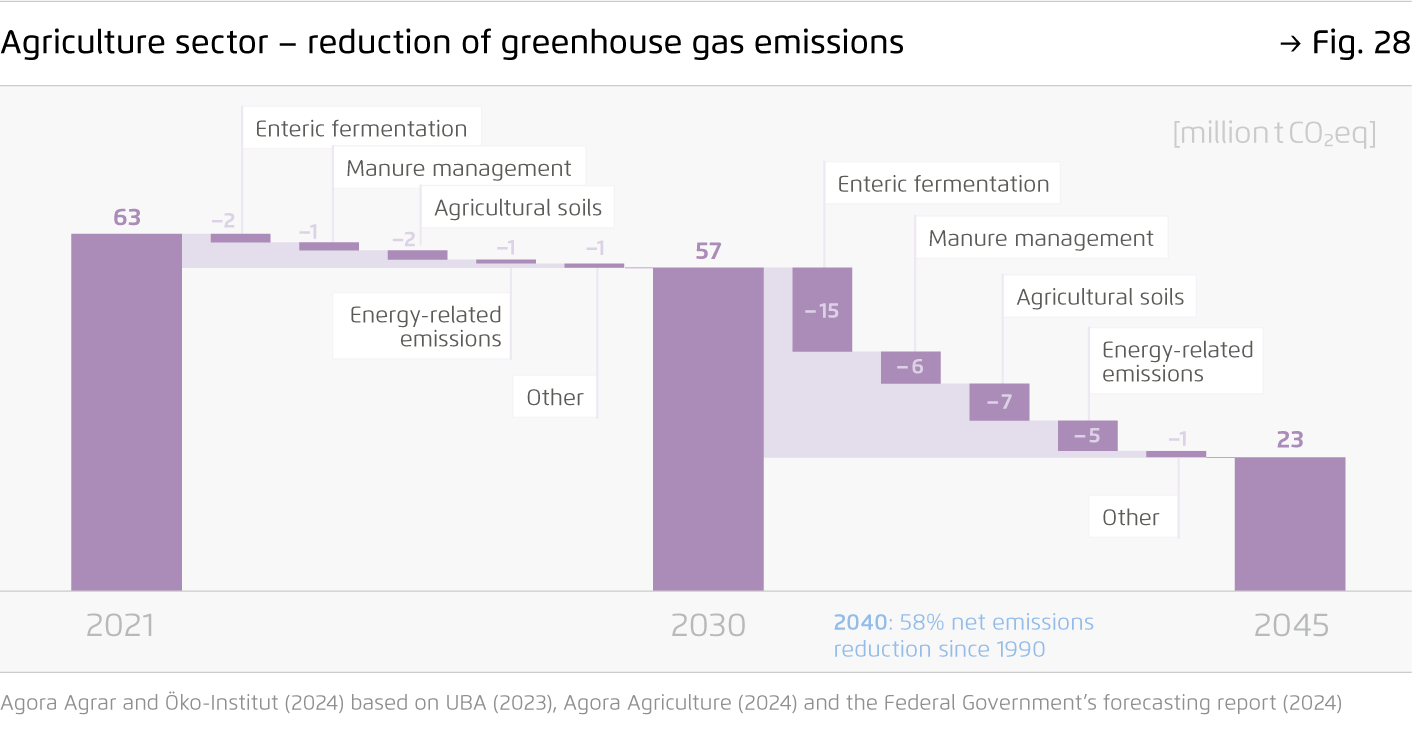
Under consideration of the Creative Commons license CC BY (attribution) the image may be further processed in any format or medium (also commercially, also in modified form), as long as the author is mentioned and a link to the license is given.
Agriculture sector – key policy instruments
Figure 33 from Climate-neutral Germany on page 49
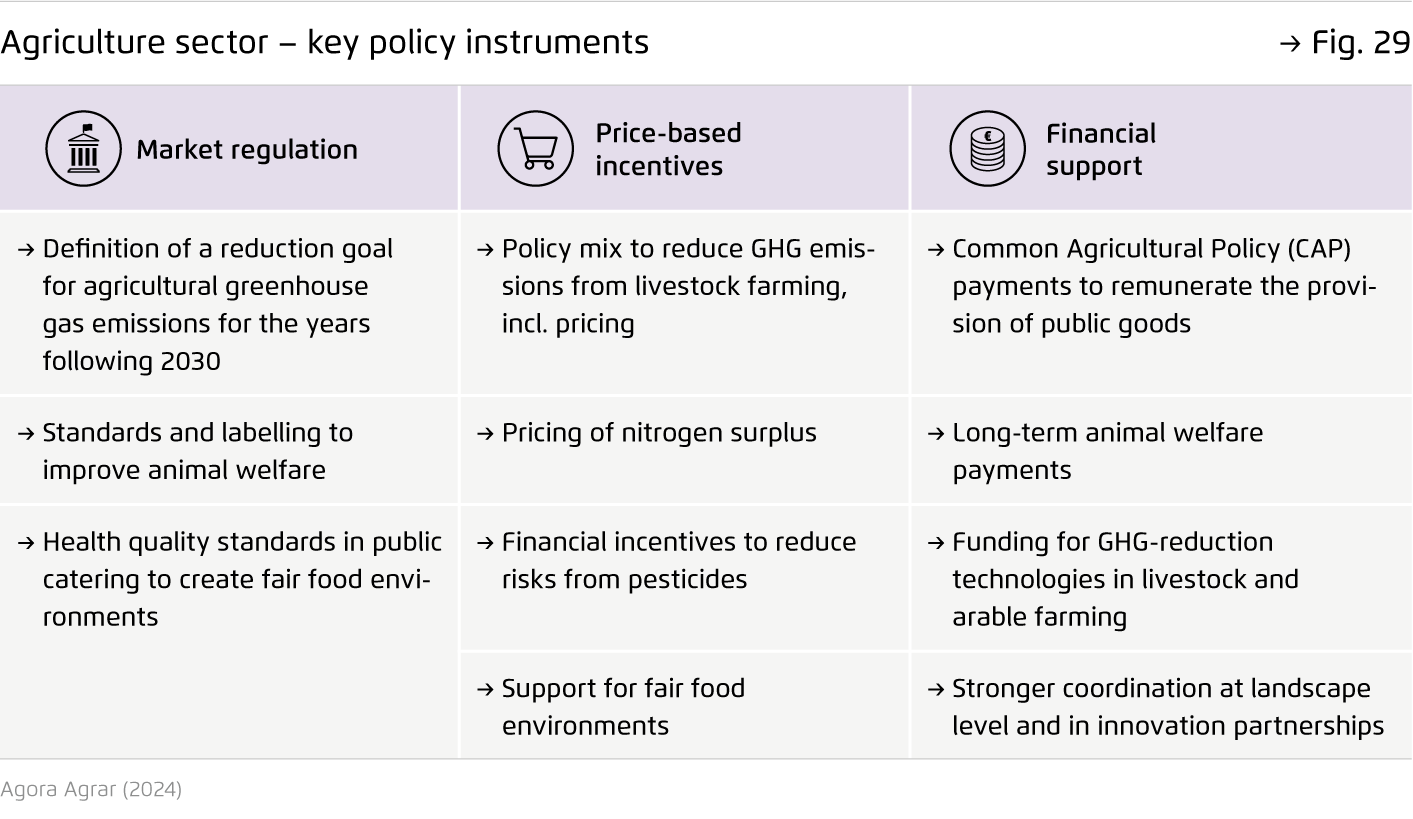
Under consideration of the Creative Commons license CC BY (attribution) the image may be further processed in any format or medium (also commercially, also in modified form), as long as the author is mentioned and a link to the license is given.
Development of livestock
Figure 34 from Climate-neutral Germany on page 50
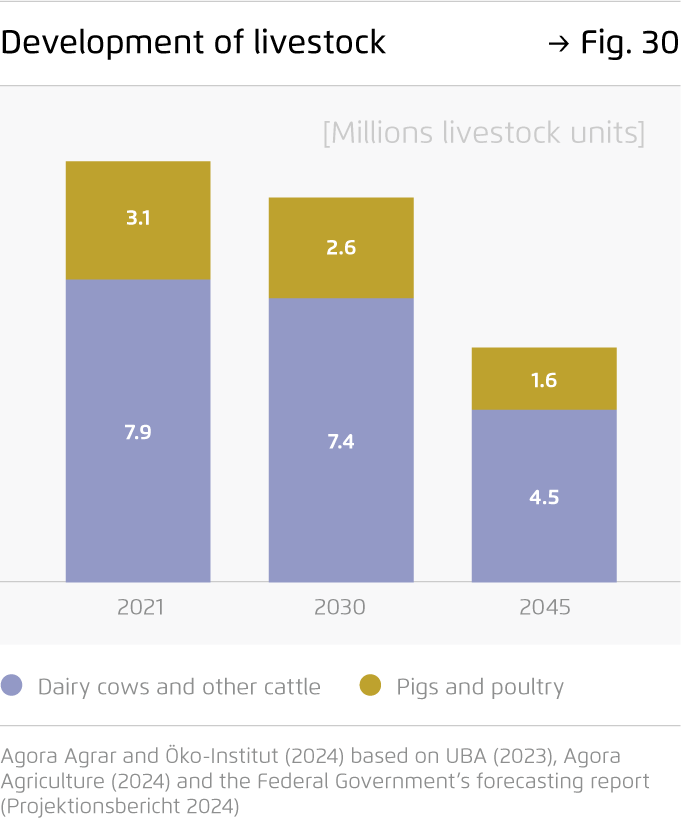
Under consideration of the Creative Commons license CC BY (attribution) the image may be further processed in any format or medium (also commercially, also in modified form), as long as the author is mentioned and a link to the license is given.
LULUCF – reduction of greenhouse gas emissions
Figure 35 from Climate-neutral Germany on page 52
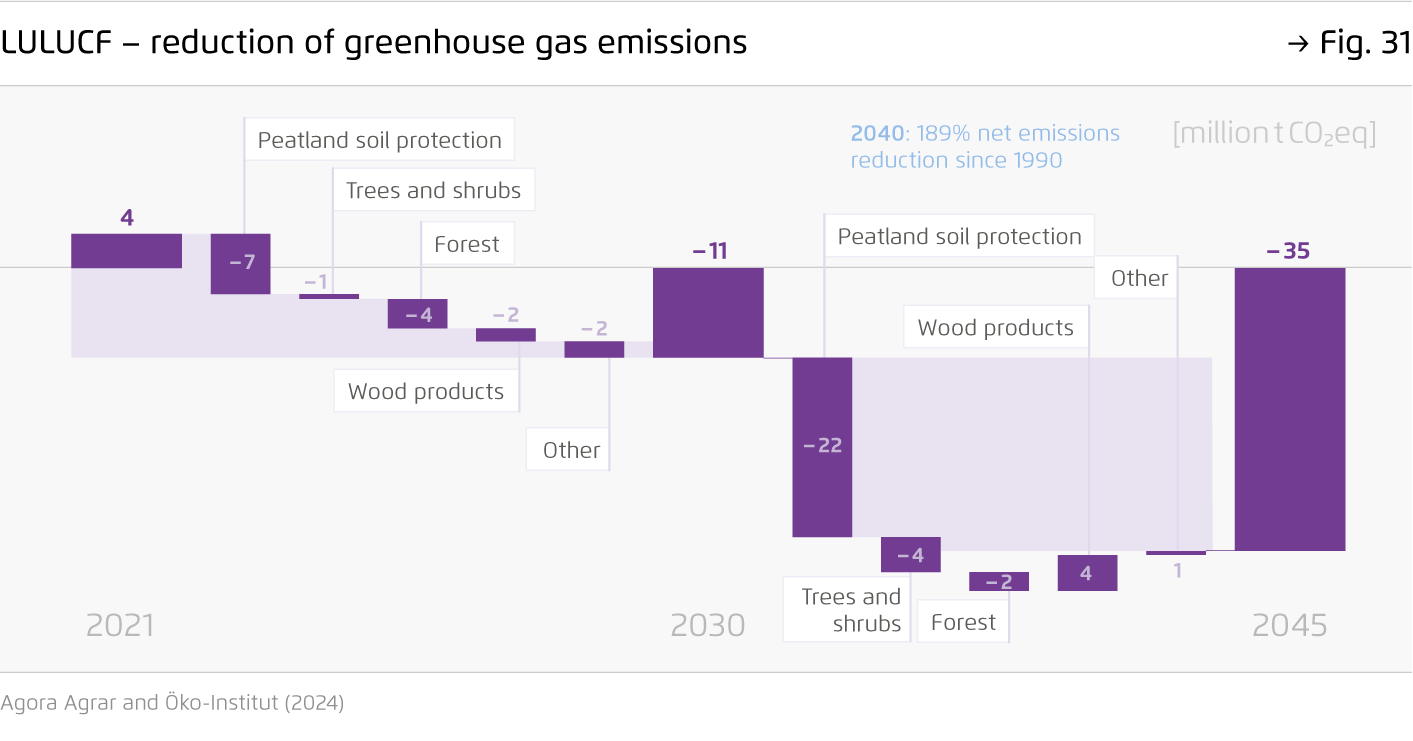
Under consideration of the Creative Commons license CC BY (attribution) the image may be further processed in any format or medium (also commercially, also in modified form), as long as the author is mentioned and a link to the license is given.
New trees and shrubs on agricultural land.
Figure 36 from Climate-neutral Germany on page 52
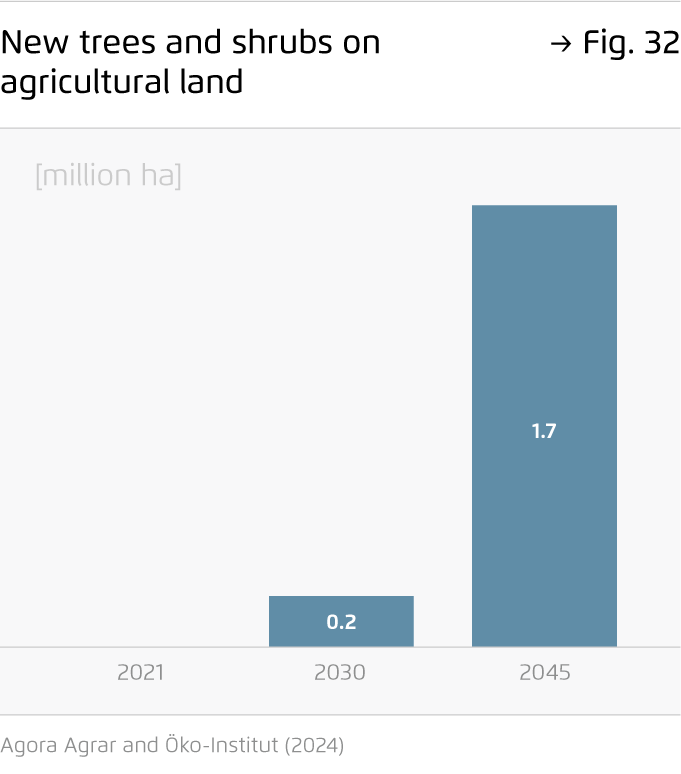
Under consideration of the Creative Commons license CC BY (attribution) the image may be further processed in any format or medium (also commercially, also in modified form), as long as the author is mentioned and a link to the license is given.
LULUCF – key policy instruments
Figure 37 from Climate-neutral Germany on page 53
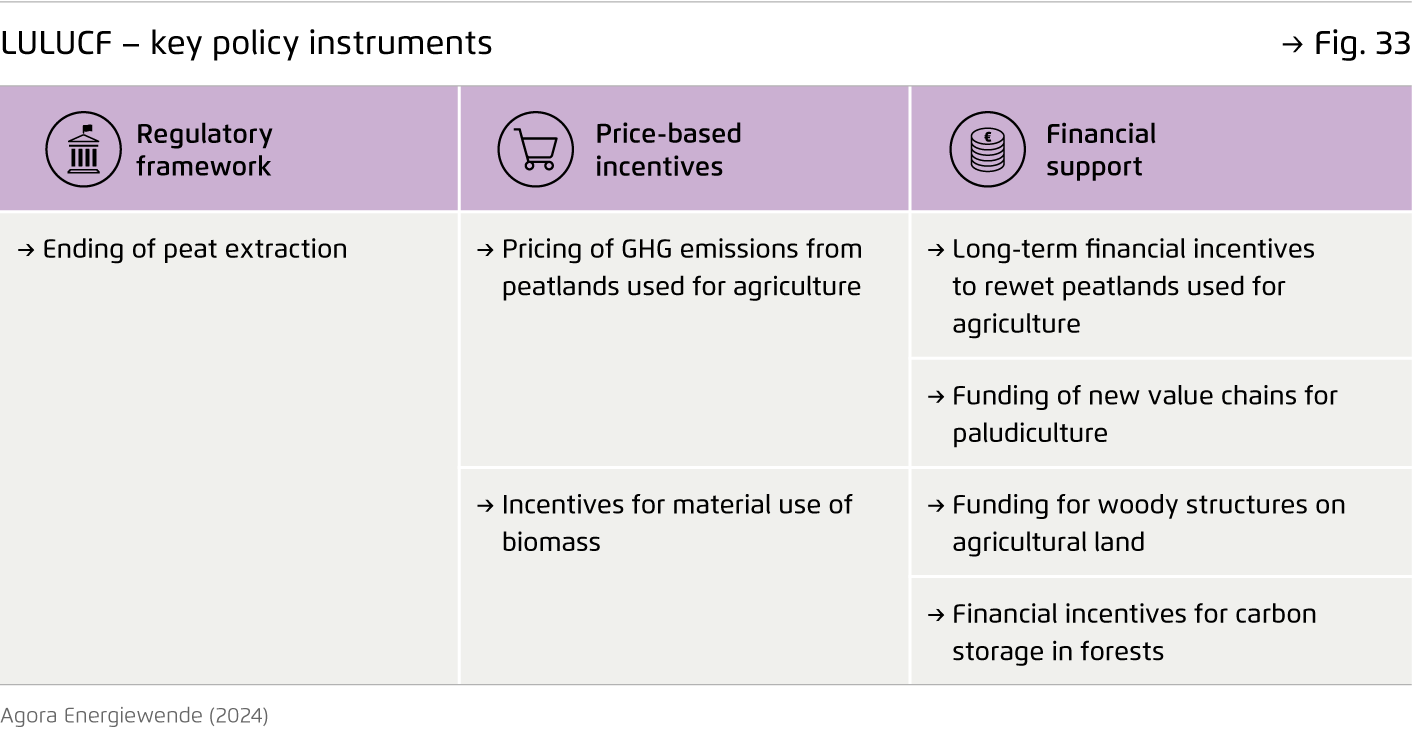
Under consideration of the Creative Commons license CC BY (attribution) the image may be further processed in any format or medium (also commercially, also in modified form), as long as the author is mentioned and a link to the license is given.
Development of land use
Figure 38 from Climate-neutral Germany on page 55
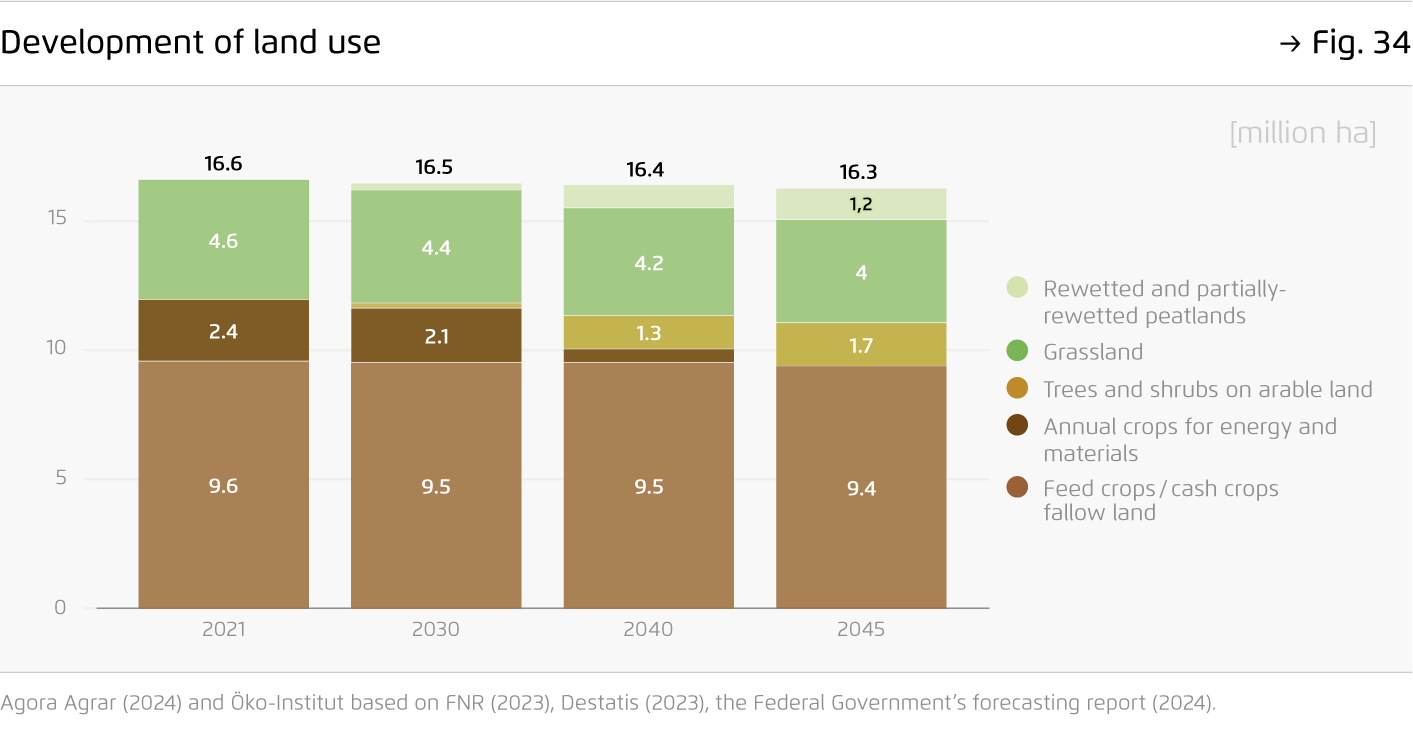
Under consideration of the Creative Commons license CC BY (attribution) the image may be further processed in any format or medium (also commercially, also in modified form), as long as the author is mentioned and a link to the license is given.
Energetic and material biomass use by sector*
Figure 39 from Climate-neutral Germany on page 56
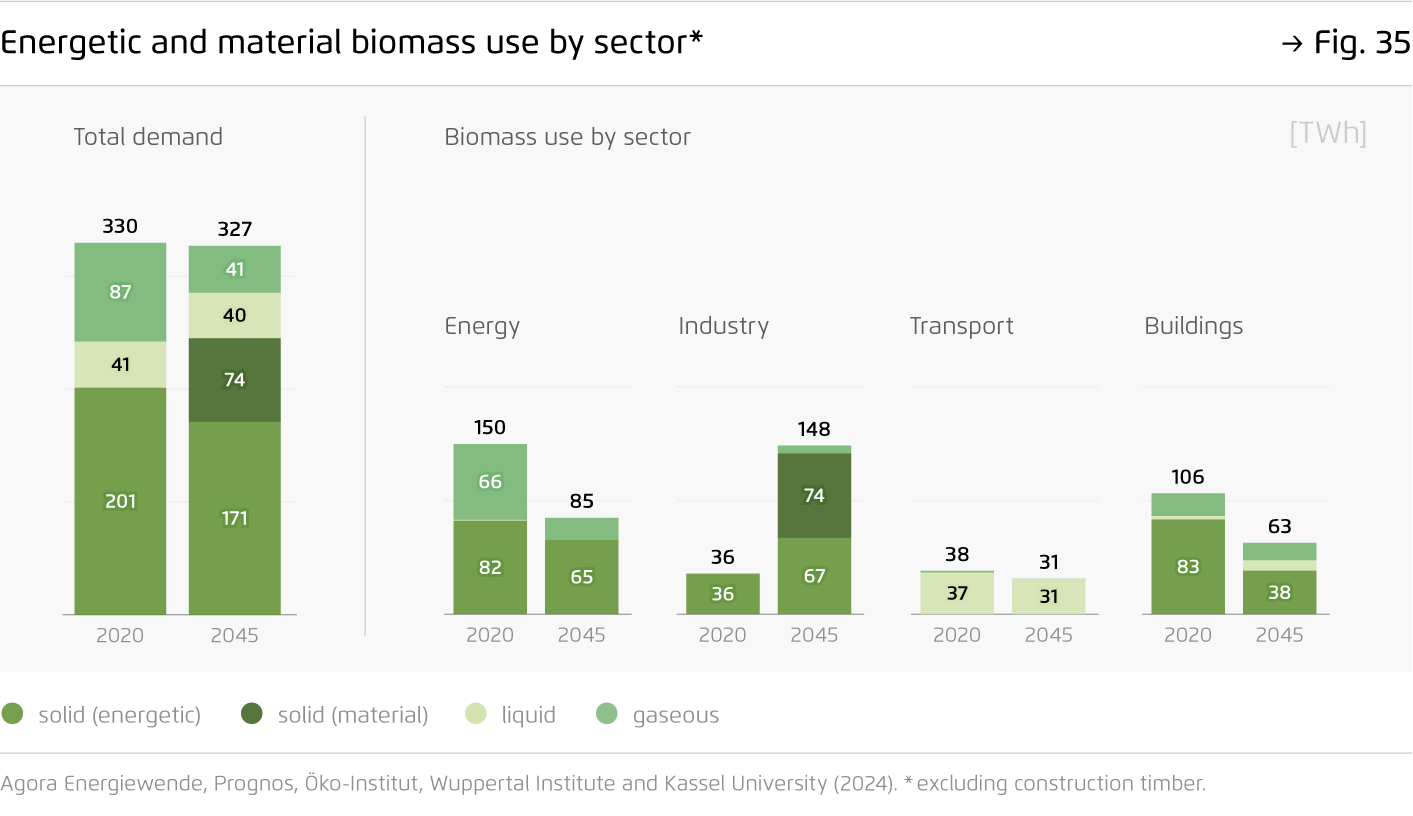
Under consideration of the Creative Commons license CC BY (attribution) the image may be further processed in any format or medium (also commercially, also in modified form), as long as the author is mentioned and a link to the license is given.
Hydrogen demand and hydrogen production
Figure 40 from Climate-neutral Germany on page 58
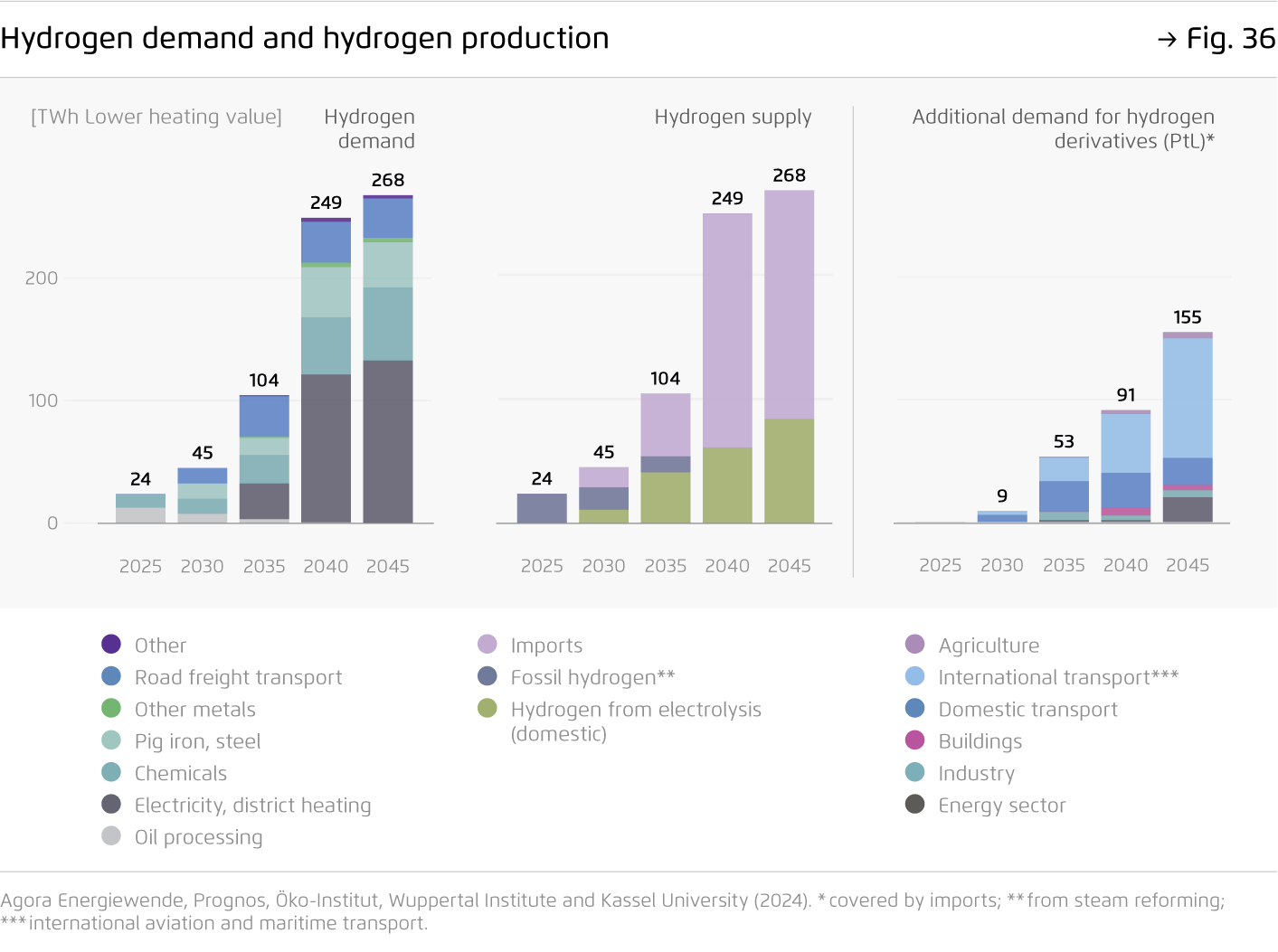
Under consideration of the Creative Commons license CC BY (attribution) the image may be further processed in any format or medium (also commercially, also in modified form), as long as the author is mentioned and a link to the license is given.
Seasonality of hydrogen production and demand in 2045
Figure 41 from Climate-neutral Germany on page 37
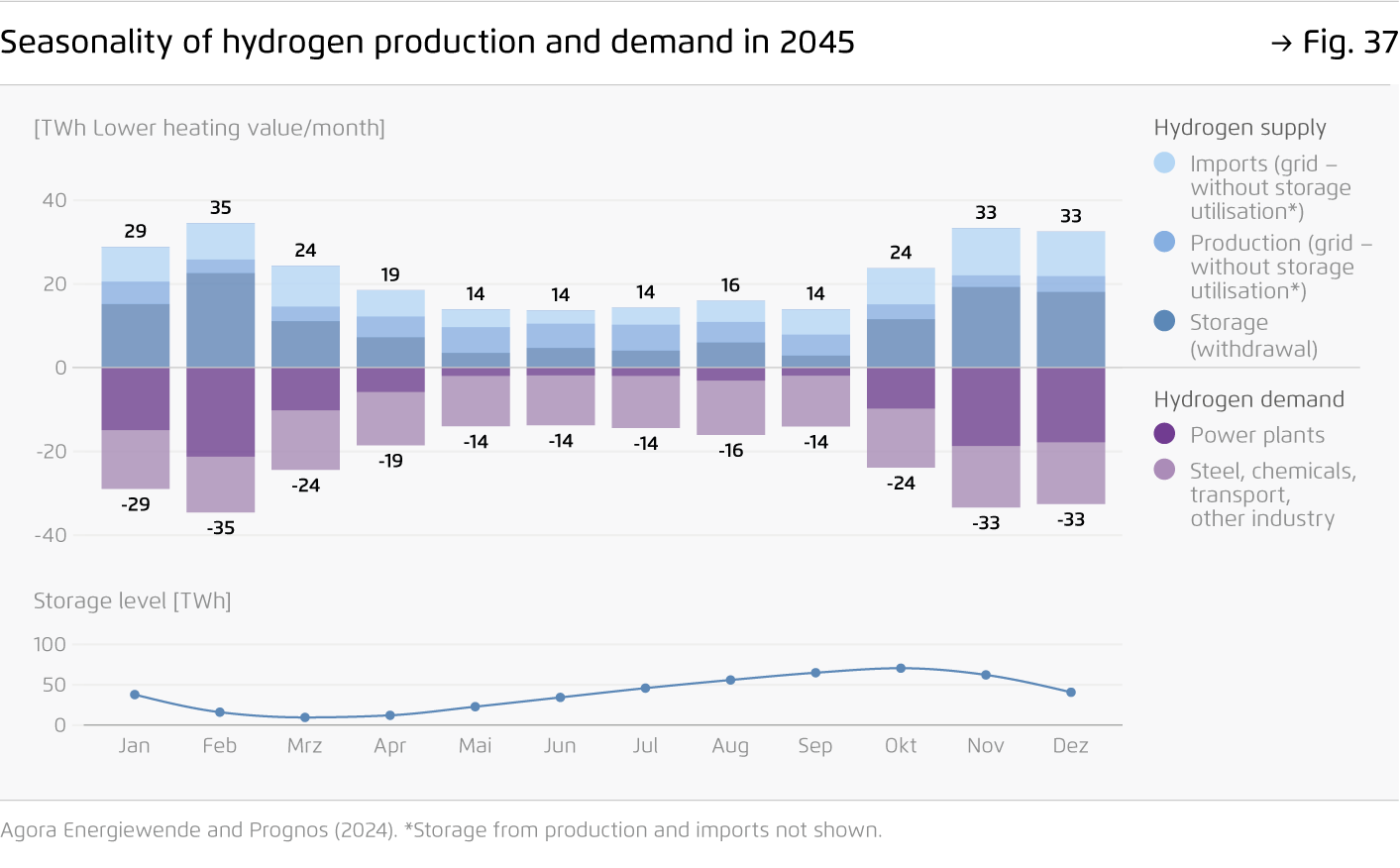
Under consideration of the Creative Commons license CC BY (attribution) the image may be further processed in any format or medium (also commercially, also in modified form), as long as the author is mentioned and a link to the license is given.
Residual emissions and their offsetting in 2045
Figure 42 from Climate-neutral Germany on page 60
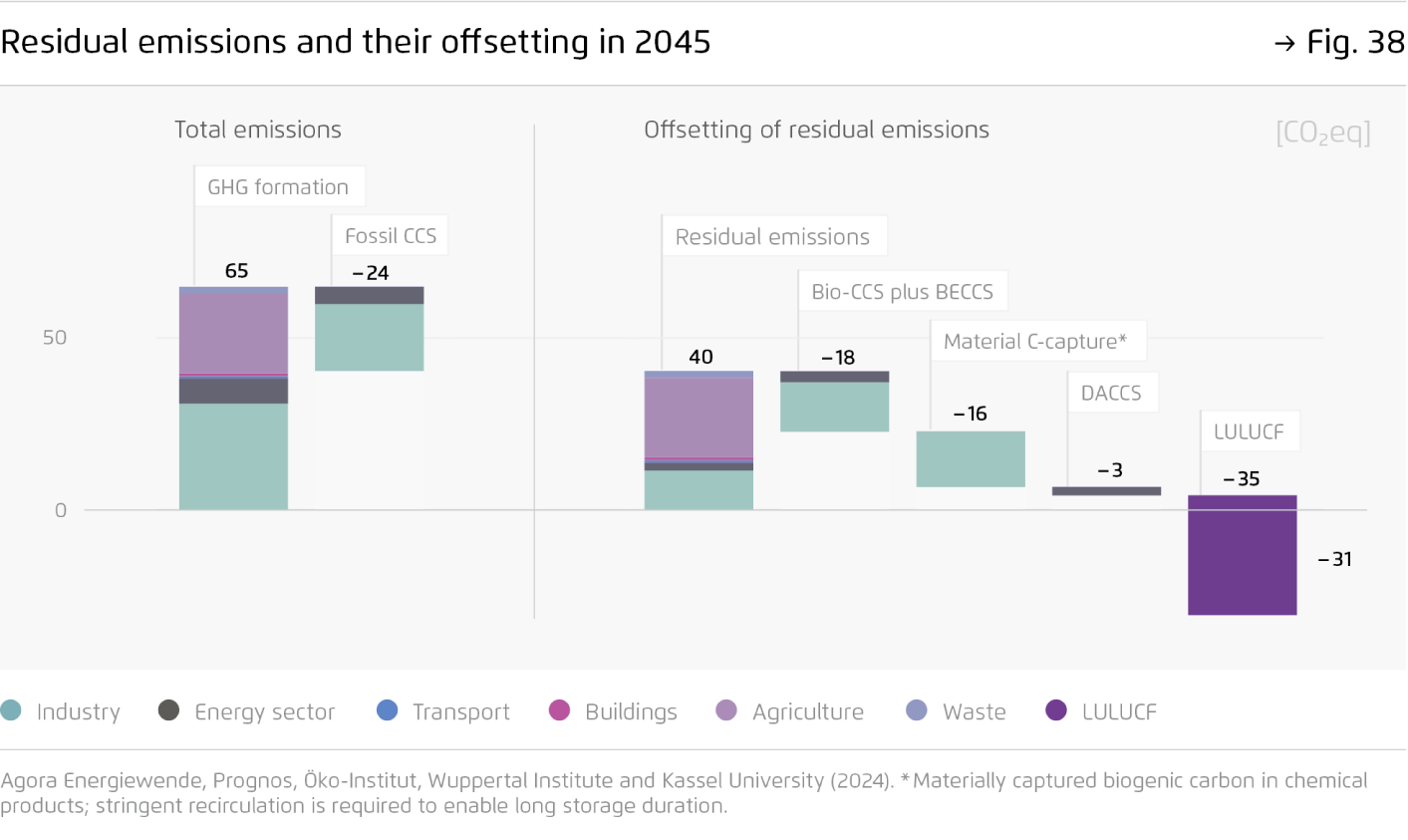
Under consideration of the Creative Commons license CC BY (attribution) the image may be further processed in any format or medium (also commercially, also in modified form), as long as the author is mentioned and a link to the license is given.
Captured and geologically stored CO2
Figure 43 from Climate-neutral Germany on page 61
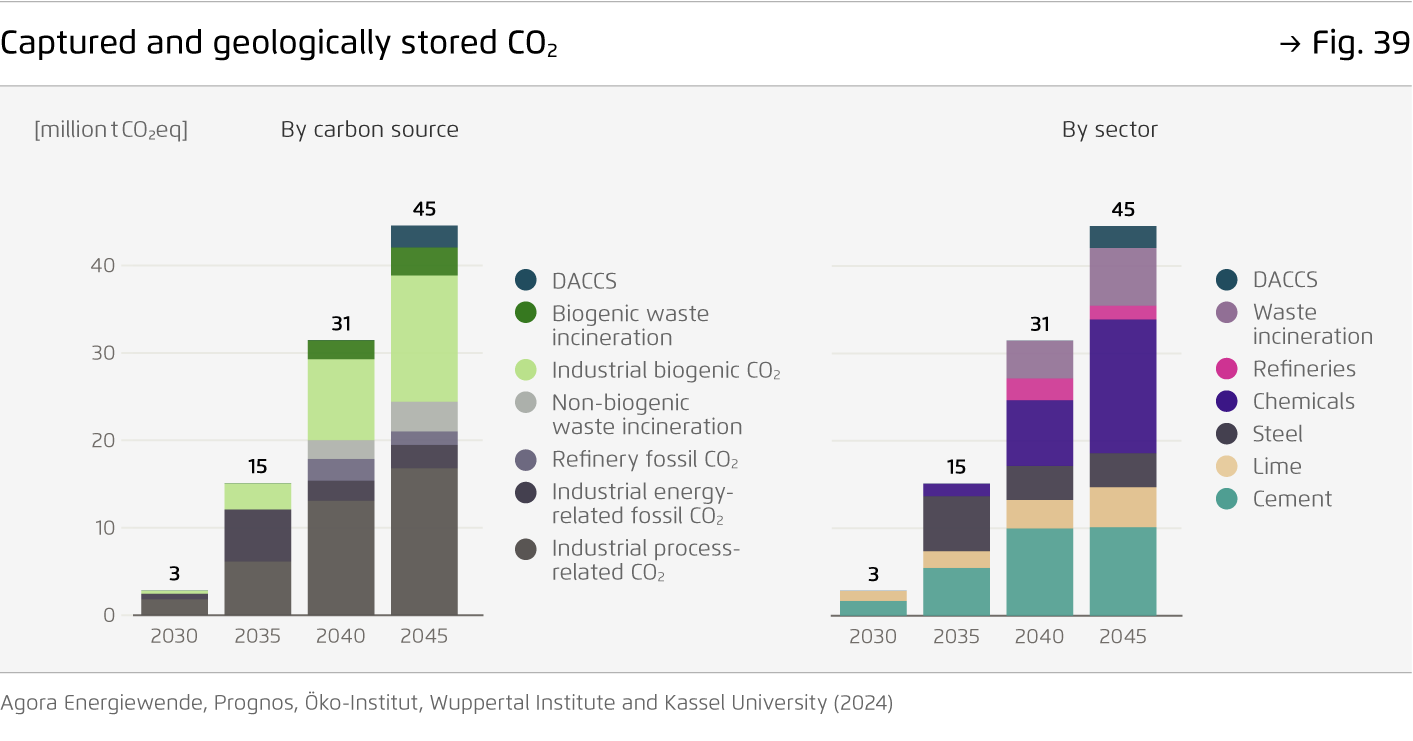
Under consideration of the Creative Commons license CC BY (attribution) the image may be further processed in any format or medium (also commercially, also in modified form), as long as the author is mentioned and a link to the license is given.
Energy sector: total and climate protection investments as an annual average and their share of gross domestic product
Figure 44 from Climate-neutral Germany on page 64
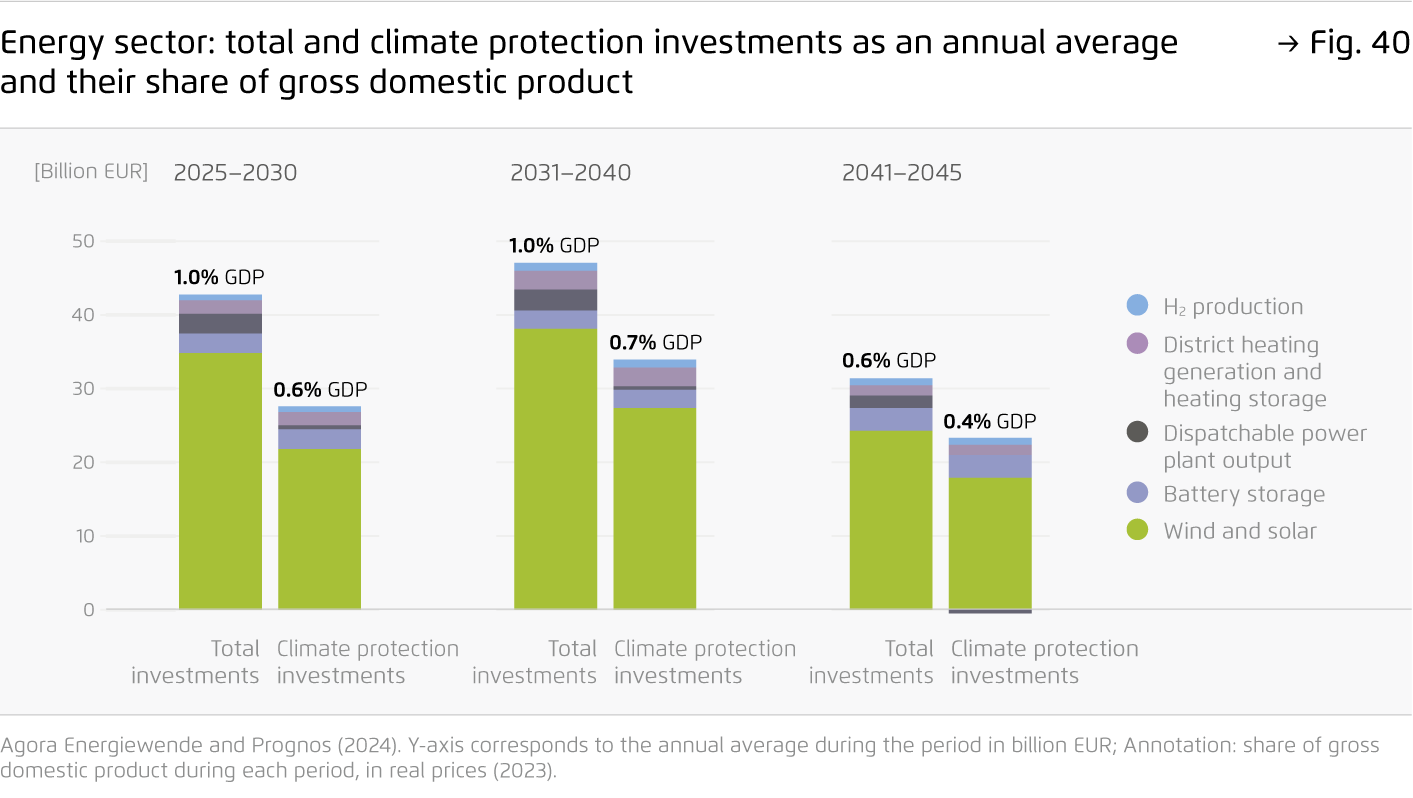
Under consideration of the Creative Commons license CC BY (attribution) the image may be further processed in any format or medium (also commercially, also in modified form), as long as the author is mentioned and a link to the license is given.
Energy infrastructure: total and climate protection investments as an annual average and their share of gross domestic product
Figure 46 from Climate-neutral Germany on page 65
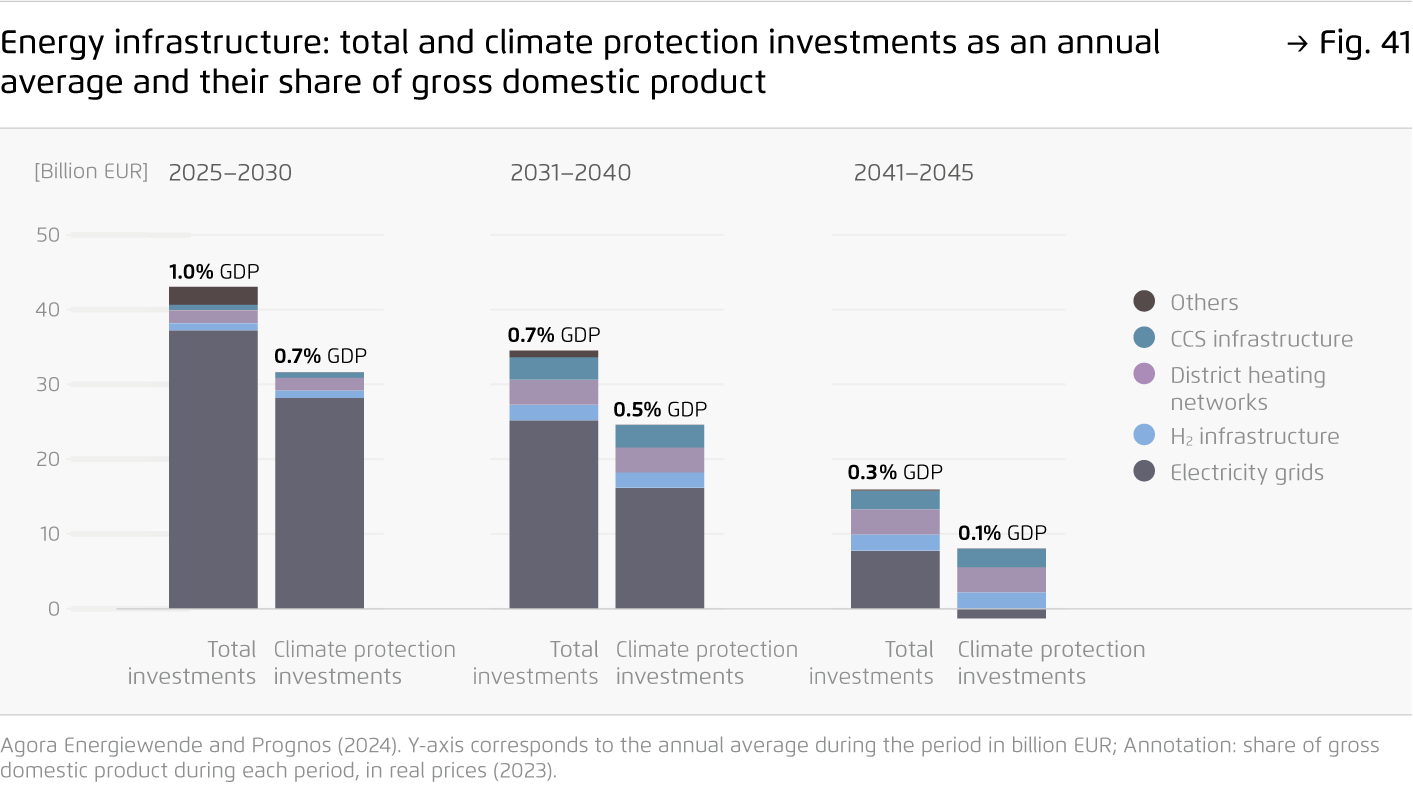
Under consideration of the Creative Commons license CC BY (attribution) the image may be further processed in any format or medium (also commercially, also in modified form), as long as the author is mentioned and a link to the license is given.
Industrial sector: total and climate protection investments as an annual average and their share of gross domestic product
Figure 46 from Climate-neutral Germany on page 66
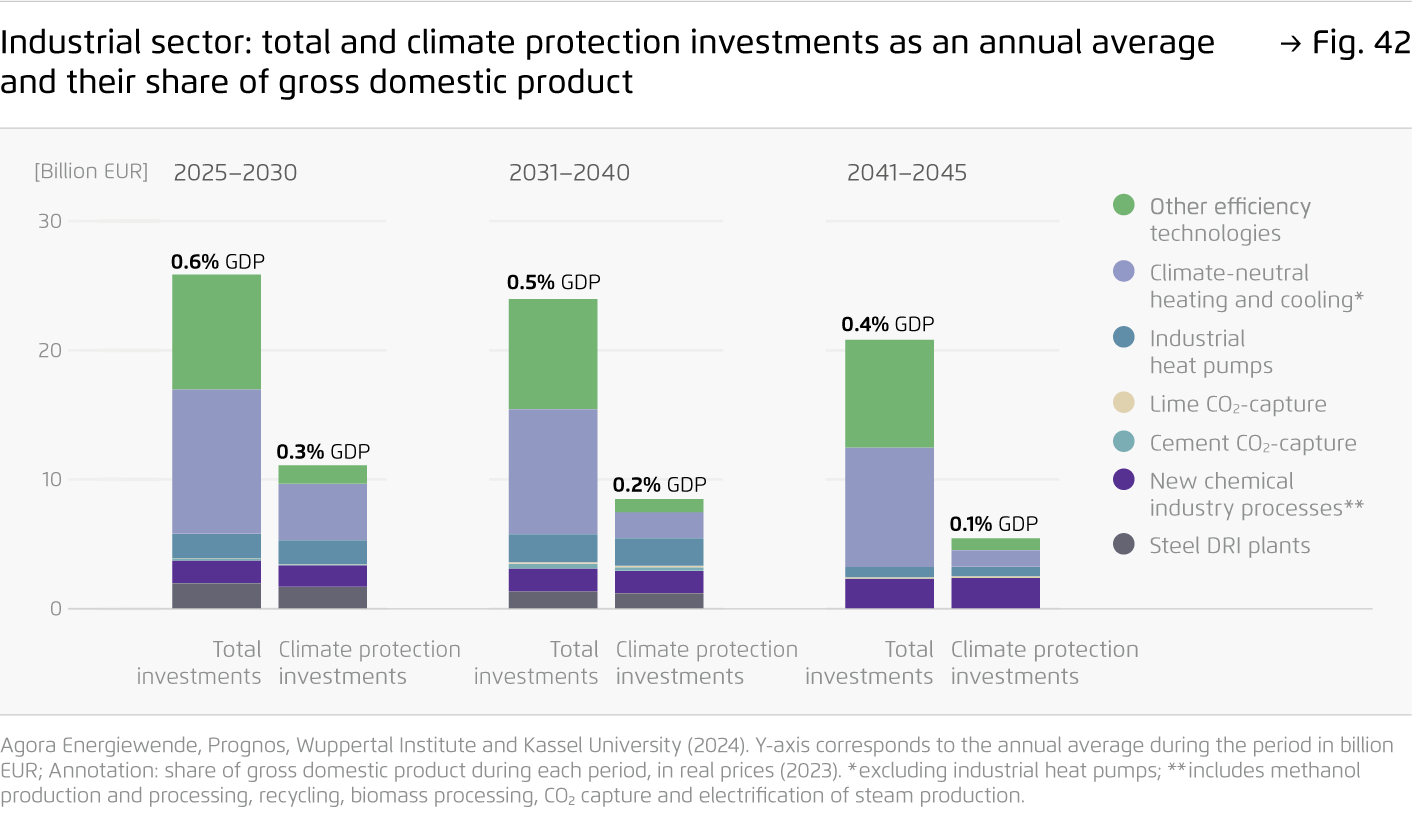
Under consideration of the Creative Commons license CC BY (attribution) the image may be further processed in any format or medium (also commercially, also in modified form), as long as the author is mentioned and a link to the license is given.
Buildings sector: total and climate protection investments as an annual average and their share of gross domestic product
Figure 47 from Climate-neutral Germany on page 68
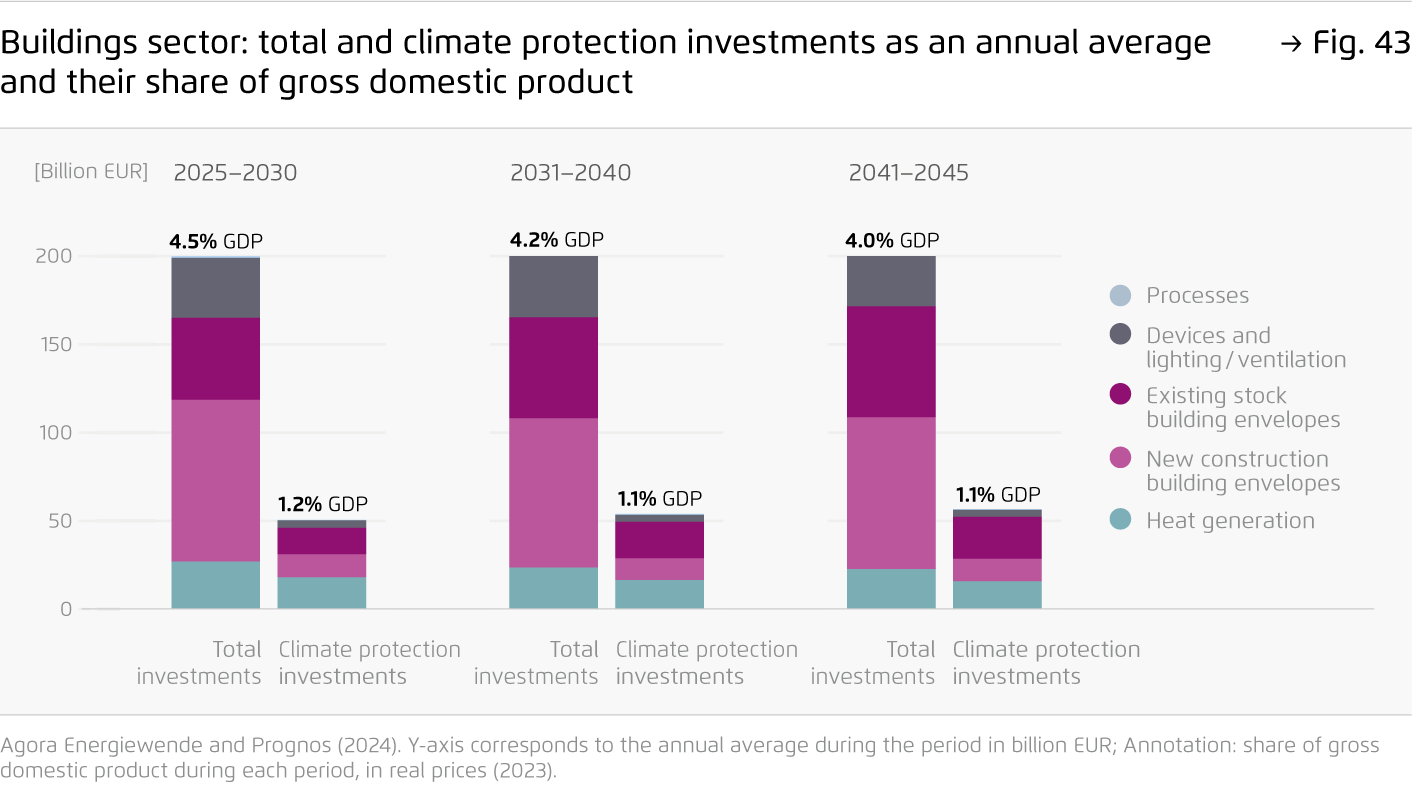
Under consideration of the Creative Commons license CC BY (attribution) the image may be further processed in any format or medium (also commercially, also in modified form), as long as the author is mentioned and a link to the license is given.
Transport sector: total and climate protection investments as an annual average and their share of gross domestic product
Figure 48 from Climate-neutral Germany on page 70
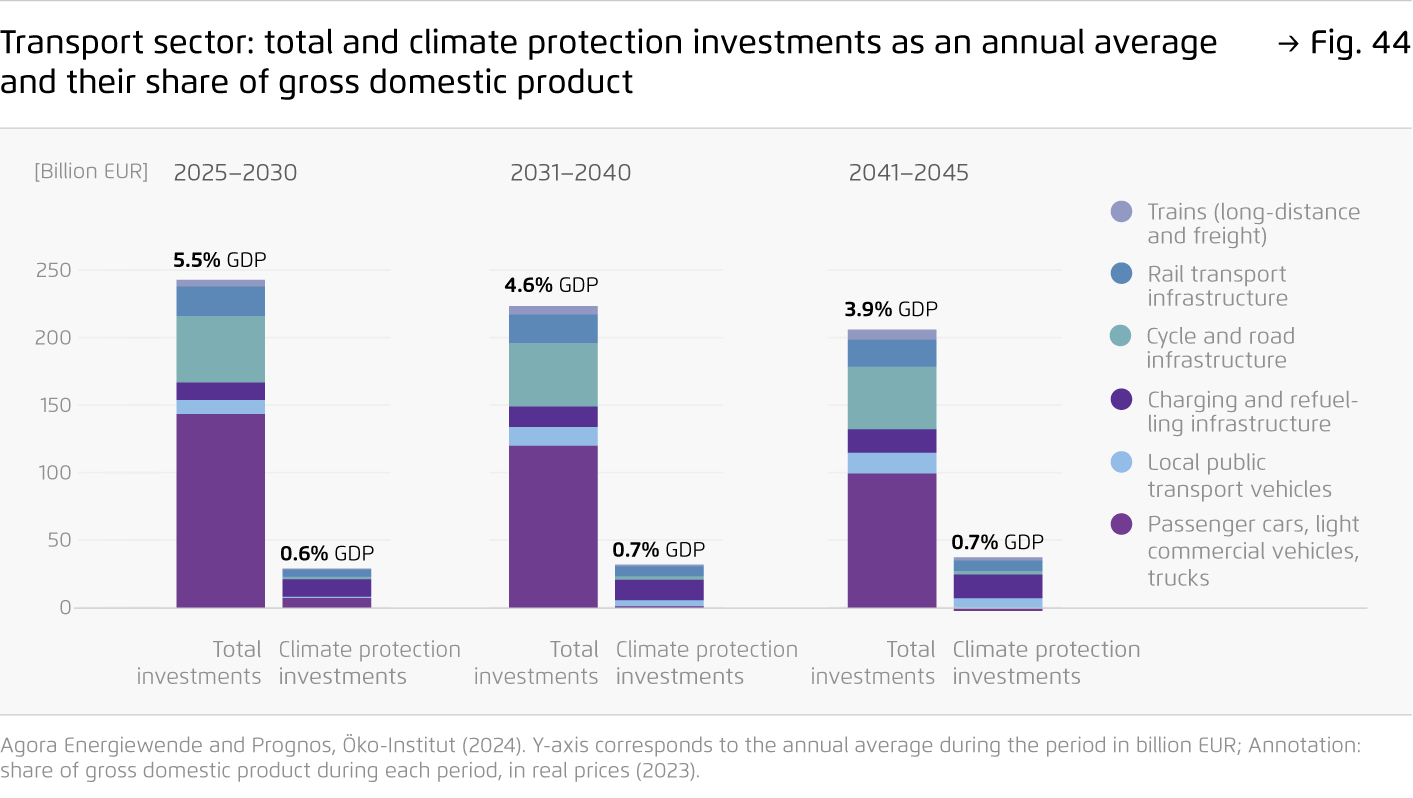
Under consideration of the Creative Commons license CC BY (attribution) the image may be further processed in any format or medium (also commercially, also in modified form), as long as the author is mentioned and a link to the license is given.


